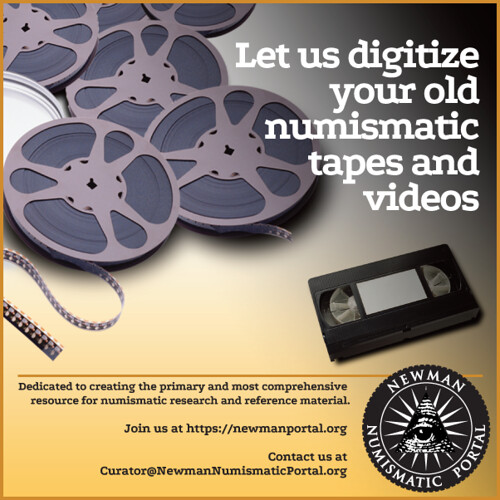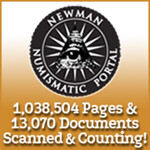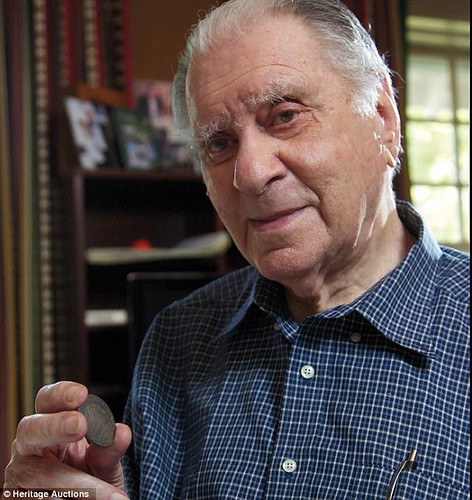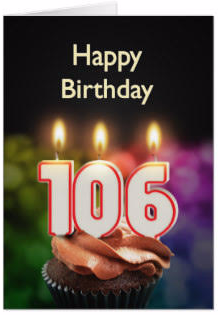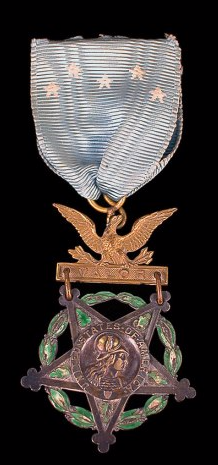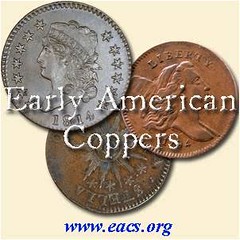
About UsThe Numismatic Bibliomania Society is a non-profit organization devoted to the study and enjoyment of numismatic literature. For more information please see our web site at coinbooks.org SubscriptionsThose wishing to become new E-Sylum subscribers (or wishing to Unsubscribe) can go to the following web page link MembershipThere is a membership application available on the web site Membership Application To join, print the application and return it with your check to the address printed on the application. Print/Digital membership is $40 to addresses in the U.S., and $60 elsewhere. A digital-only membership is available for $25. For those without web access, write to: Terry White, Treasurer
AsylumFor Asylum mailing address changes and other membership questions, contact Terry at this email address: terrywhite5475@yahoo.com SubmissionsTo submit items for publication in The E-Sylum, just Reply to this message, or write to the Editor at this address: whomren@gmail.com BUY THE BOOK BEFORE THE COINSale Calendar
|
- WAYNE'S WORDS: THE E-SYLUM MAY 21, 2017
- ASYLUM SUMMER 2017 ISSUE PUBLISHED
- 2017 NBS ELECTION CANDIDATES
- KOLBE & FANNING BUY OR BID SALE CLOSES JUNE 3, 2017
- NEW BOOK: MEGA RED 3RD EDITION
- NEW BOOK: THE SS GAIRSOPPA SILVER TREASURE
- NEW BOOK: HIGHFILL SILVER DOLLARS 2017 EDITION
- RUSS SEARS (1942-2017)
- CATHERINE BULLOWA-MOORE (1919-2017)
- DIGITIZED: AMERICAN NUMISMATIC RARITIES CATALOGS
- HAPPY BIRTHDAY #106, ERIC P. NEWMAN
- COINWEEK HITS YOUTUBE AND FACEBOOK MILESTONES
- NOTES FROM E-SYLUM READERS: MAY 21, 2017
- NOTRE DAME STUDY OF PRE-FEDERAL MONEY
- MERCANTI ACCEPTS DAVID RITTENHOUSE AWARD
- VOCABULARY TERM: REGISTER
- JOHN EDGAR BURTON (1847-1930)
- ARTICLE EXAMINES ANCIENT COIN DEALER FREEMAN
- STUDY EXAMINES RARE COIN INVESTMENT RETURNS
- COINTELEVISION INTERVIEWS FOLEY, THREE YNS
- COIN DEALER MAURICE A. STORCK
- TWO 1960S CELEBRITY AUTOGRAPHED NOTES
- NUMISMATIC NUGGETS: MAY 21, 2017
- DOGS ON ANCIENT COINS
- THE HOUSE OF WINDSOR CENTENNIAL CROWN
- THE DRUMMER BOY'S MEDAL OF HONOR
- STAMP SCRIP IN THE GREAT DEPRESSION
- BREAD TAG BONANZA
- FRANKENSTEIN COUNTERFEITS SPLICED AND TAPED
- HONG KONG STUDY EXAMINES BANKNOTE BACTERIA
Click here to access the complete archive
To comment or submit articles, reply to whomren@gmail.com
Content presented in The E-Sylum is not necessarily researched or independently fact-checked, and views expressed do not necessarily represent those of the Numismatic Bibliomania Society.
WAYNE'S WORDS: THE E-SYLUM MAY 21, 2017
 New subscribers this week include: Jim Hicks, courtesy of James Barry; Helen Wang and Leuteris Flytzanis. Welcome aboard! We now have 3,250 subscribers.
New subscribers this week include: Jim Hicks, courtesy of James Barry; Helen Wang and Leuteris Flytzanis. Welcome aboard! We now have 3,250 subscribers.
Thank you for reading The E-Sylum. If you enjoy it, please send me the email addresses of friends you think may enjoy it as well and I'll send them a subscription with your compliments. Contact me at whomren@gmail.com anytime regarding your subscription, or questions, comments or suggestions about our content.
This week we open with a new issue of The Asylum, elections for NBS officers, a new sale from Kolbe & Fanning, three new books and word of the loss of two hobby leaders.
Other topics this week include a birthday for America's numismatic elder statesman Eric P. Newman, the David Rittenhouse Award, American Numismatic Rarities, collector John Edgar Burton, dealer Maurice Storck, the House of Windsor centennial crown, and Depression stamp scrip.
To learn more about the SS Gairsoppa, diaper dies, the Confederate "Dime", the world's worst 1802 Half Dime, the Hippodrome token, the Drummer Boy's Medal of Honor, Frankenstein banknotes and the guy who still owns most of the coins he purchased in person at the 1954 Farouk sale, read on. Have a great week, everyone!
Wayne Homren
Editor, The E-Sylum
ASYLUM SUMMER 2017 ISSUE PUBLISHED
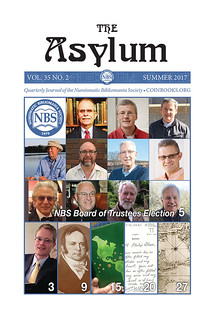 The Asylum v35 n2 Summer 2017
The Asylum v35 n2 Summer 2017
Table of Contents
NBS 2017 Board of Trustees Slate of Candidates
Benjamin Bell: Memories of a Good Friend by Carlos Jara and David Fanning
United States Numismatic Literature from 1943 by YN Kellen Hoard
A Teeny Island of Numismatic Bibliophile Bindings by George F. Kolbe
ASSOCIATIONS: Autographs • Annotations • Inscriptions by Joel J. Orosz
Jorge Ferrari’s Unpublished Magnum Opus by John W. Adams
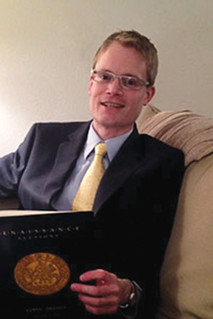
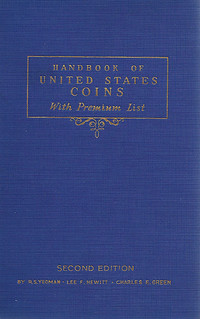
Benjamin Bell; 1943 Blue Book
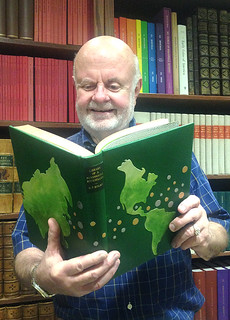

George Kolbe; Ferrari's Unpublished Magnum Opus
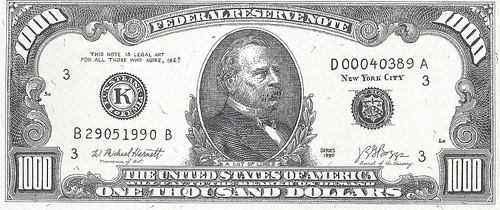
J.S.G. Boggs Legal Art $1,000 Bill
Message From the President
Dear Friends,
This is the last message I will be sending to all of you, as my tenure as your President is ending as soon as the election votes are counted. The incoming Officers and Board of Trustees slate is packed with strong leaders and bibliophiles. With the addition of new faces on the Board, our organization will remain a vibrant part of the numismatic community. I would like to leave office with a few thoughts on the NBS, and my hopes for the future.
While change is sometimes hard to accept, or even comprehend, we as literature collectors are faced with a somewhat perplexing problem. New technologies have allowed us to digitize the content of most of the extant numismatic literature with appropriate permissions. When I first heard about the Newman Portal, I was a bit skeptical of the possibilities. But now that I have seen its true potential, I am in awe of its capabilities, and its usefulness in the research communities. Hence the dilemma…If we should “buy the book before the coin,” what would compel us to purchase, much less collect, numismatic literature if it is easily accessible online?
My answer is quite simple. Any of you who have entered a public or private library, bookstore, or rare book room, and have held history in your hands, can attest that the feeling is quite unique and thrilling. The smell of the book, the beauty of the binding, and the feel of the old, fragile pages in your hand, can take us all back in time to the world of the author, and the state of the hobby at that moment. A computer screen has yet to replicate that feeling, that excitement when we purchase a rarity, hold it in our hands, and put it on your shelf. I hope it never does.
So, my friends, let us go boldly into the future together. There should be a respectful balance between the newest technologies and the physical world of numismatic literature. I see an important place for both in the future of collecting.
Thank you all for mentoring and guiding me through my collecting journey the past 35 years, and I look forward to continuing to support the NBS long into the future. It has been an honor to serve as an Officer for the past 6 years.
With warmest regards,
Marc Charles Ricard
To join NBS or renew your annual membership, see:
http://www.coinbooks.org/about/membership.html
THE BOOK BAZARRE
2017 NBS ELECTION CANDIDATES
NBS 2017 Board of Trustees Slate of Candidates
2017 is an election year for the Numismatic Bibliomania Society’s Board of Trustees. Please use the ballot that has been enclosed with this issue to vote for the NBS members who have volunteered to serve for the 2017–2019 term. Please return ballots by June 30, 2017.
President
Tom Harrison
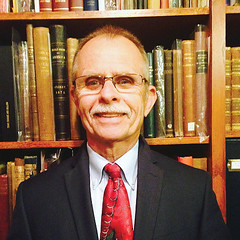 Like many of you, I was born a collector. When my grandmother gave me a small box of coins collected by her father, my other collecting interests waned. When I took a hiatus from the hobby,
my books went into storage and my only numismatic lifeline was my NBS membership that dated to the society’s inception. In 2008 my mania rekindled and in 2010, I transferred my NBS membership to
lifetime status. I look forward to serving the membership as we maintain the rich traditions of the NBS by promoting the appreciation and preservation of numismatic literature.
Like many of you, I was born a collector. When my grandmother gave me a small box of coins collected by her father, my other collecting interests waned. When I took a hiatus from the hobby,
my books went into storage and my only numismatic lifeline was my NBS membership that dated to the society’s inception. In 2008 my mania rekindled and in 2010, I transferred my NBS membership to
lifetime status. I look forward to serving the membership as we maintain the rich traditions of the NBS by promoting the appreciation and preservation of numismatic literature.
Vice-President
Len Augsburger
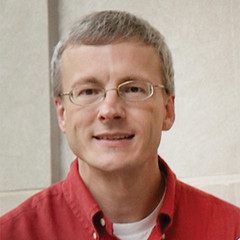 Len Augsburger serves as Project Coordinator for the Newman Numismatic Portal at Washington University in St. Louis, and has written widely in the field of American numismatics. He has won
two Book of the Year awards from the Numismatic Literary Guild, and recently published, with co-authors Joel Orosz and Pete Smith, 1792: Birth of a Nation’s Coinage. In conjunction with this
work, Augsburger cataloged the Donald Partrick collection of patterns of 1792 sold by Heritage Auctions in 2015. A Fellow of the American Numismatic Society, Augsburger also serves as vice president
of the Liberty Seated Collectors Club.
Len Augsburger serves as Project Coordinator for the Newman Numismatic Portal at Washington University in St. Louis, and has written widely in the field of American numismatics. He has won
two Book of the Year awards from the Numismatic Literary Guild, and recently published, with co-authors Joel Orosz and Pete Smith, 1792: Birth of a Nation’s Coinage. In conjunction with this
work, Augsburger cataloged the Donald Partrick collection of patterns of 1792 sold by Heritage Auctions in 2015. A Fellow of the American Numismatic Society, Augsburger also serves as vice president
of the Liberty Seated Collectors Club.
Secretary/Treasurer
Terry White
 I grew up and spent my early professional life in Indiana. I have spent the last fifteen years in Ohio, and the last eight years in Columbus, Ohio as President of United Midwest Savings
Bank, a premier SBA lender. I have been a banker for 35 years, I have been married to LouAnn for nearly 34 years, and have been collecting coins and books for most of this time. I collect mostly
copper, with tokens being a favorite.
I grew up and spent my early professional life in Indiana. I have spent the last fifteen years in Ohio, and the last eight years in Columbus, Ohio as President of United Midwest Savings
Bank, a premier SBA lender. I have been a banker for 35 years, I have been married to LouAnn for nearly 34 years, and have been collecting coins and books for most of this time. I collect mostly
copper, with tokens being a favorite.
I am pleased to serve as Treasurer of NBS, as it combines my two collecting interests. I hope to help the club grow in any way I can.
Trustees (Vote for Six)
John W. Adams
 John W. Adams has been NBS Vice President and board member from 2001–2007, and President 2007–2009, as well as being President of the Medal Collectors of America (MCA) 2005–2009, and editor
of Medals Collectors Advisory since 2004. Among his several books on numismatics, his two volumes of United States Numismatic Literature are among the most useful bibliographical aids
on American numismatic auction catalogues available. He earned the ANS Archer M. Huntington Award for excellence in numismatic scholarship in 2014 and is an ANS Honorary Trustee, Fellow, and Augustus
B. Sage Society member. His research in the field of numismatics focuses on American and European medals, numismatic literature, and large cents.
John W. Adams has been NBS Vice President and board member from 2001–2007, and President 2007–2009, as well as being President of the Medal Collectors of America (MCA) 2005–2009, and editor
of Medals Collectors Advisory since 2004. Among his several books on numismatics, his two volumes of United States Numismatic Literature are among the most useful bibliographical aids
on American numismatic auction catalogues available. He earned the ANS Archer M. Huntington Award for excellence in numismatic scholarship in 2014 and is an ANS Honorary Trustee, Fellow, and Augustus
B. Sage Society member. His research in the field of numismatics focuses on American and European medals, numismatic literature, and large cents.
David F. Fanning
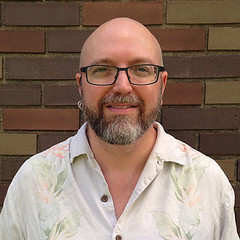 David F. Fanning holds a Ph.D. in English from the Ohio State University and has been a student of numismatic literature since childhood. He is a life member of the American Numismatic
Association and Numismatic Bibliomania Society, and serves on the Board of Trustees of the latter. In 2014, he was elected a Fellow of the American Numismatic Society and the following year was
elected a member of the Rittenhouse Society. He is also a Fellow of the Royal Numismatic Society and belongs to many specialized and regional numismatic organizations. A principal of Kolbe &
Fanning Numismatic Booksellers, he has published widely on numismatic literature, North American colonial coins, medals, U.S. federal coins, Islamic coins and other topics. His primary collecting
interests are Canadian colonial tokens as well as the coins of early medieval Europe and the early Islamic world—as well as the relevant literature, of course!
David F. Fanning holds a Ph.D. in English from the Ohio State University and has been a student of numismatic literature since childhood. He is a life member of the American Numismatic
Association and Numismatic Bibliomania Society, and serves on the Board of Trustees of the latter. In 2014, he was elected a Fellow of the American Numismatic Society and the following year was
elected a member of the Rittenhouse Society. He is also a Fellow of the Royal Numismatic Society and belongs to many specialized and regional numismatic organizations. A principal of Kolbe &
Fanning Numismatic Booksellers, he has published widely on numismatic literature, North American colonial coins, medals, U.S. federal coins, Islamic coins and other topics. His primary collecting
interests are Canadian colonial tokens as well as the coins of early medieval Europe and the early Islamic world—as well as the relevant literature, of course!
Dan Hamelberg
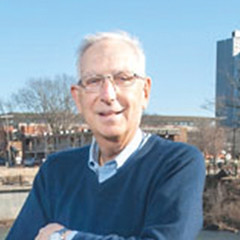 Dan Hamelberg is a current ANS Trustee, an ANA & ANS Life Member, a Member EAC, FUN, LSCC, C4, Flying Eagle & Indian Cent Collectors Society. He is also a past NBS President and has
been a board member for many years, as well as receiving the NBS’s George F. Kolbe Award for Lifetime Achievement Numismatic Literature. He has assembled a significant U.S. Coin collection of “First
Year of Type” and a comprehensive collection of U.S. Numismatic Literature.
Dan Hamelberg is a current ANS Trustee, an ANA & ANS Life Member, a Member EAC, FUN, LSCC, C4, Flying Eagle & Indian Cent Collectors Society. He is also a past NBS President and has
been a board member for many years, as well as receiving the NBS’s George F. Kolbe Award for Lifetime Achievement Numismatic Literature. He has assembled a significant U.S. Coin collection of “First
Year of Type” and a comprehensive collection of U.S. Numismatic Literature.
“I believe the NBS Constitution needs a significant update in order to expand opportunities and to clarify responsibilities within the NBS. I would like to see more engagement with young collectors as they are the future of our hobby. The NBS needs and deserves an active board of directors with officers to match to maintain and improve a society devoted to the hobby of Numismatic Literature.”
David Hill
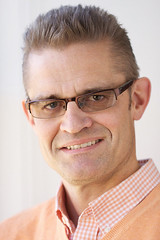 David Hill is the Librarian and Archivist at the American Numismatic Society, and he also oversees the satellite operation of the Newman Numismatic Portal that is based there. He has over
twenty-five years of experience working with books and archival materials, having held positions at the Columbia University Archives and Columbiana Library, the Berkshire County Historical Society
(Massachusetts), the Westchester County Archives, and Iona College Library (New Rochelle, N.Y.). He has been with the ANS since 2010. His numerous articles on numismatics and numismatic literature
have appeared in ANS Magazine and The Asylum.
David Hill is the Librarian and Archivist at the American Numismatic Society, and he also oversees the satellite operation of the Newman Numismatic Portal that is based there. He has over
twenty-five years of experience working with books and archival materials, having held positions at the Columbia University Archives and Columbiana Library, the Berkshire County Historical Society
(Massachusetts), the Westchester County Archives, and Iona College Library (New Rochelle, N.Y.). He has been with the ANS since 2010. His numerous articles on numismatics and numismatic literature
have appeared in ANS Magazine and The Asylum.
John Lupia
 John N. Lupia, III, has been a serious collector, appraiser, and occasional dealer in antiques, stamps, coins and rare books since 1964. He has amassed an extensive library of American and
foreign coin auction sales catalogues and rare numismatic literature in several languages. As an archaeologist and art historian he is widely published, and has more recently these past fifteen years
focused on American numismatic history. He is, perhaps, more well known through his website NumismaticMall.com created and designed to promote global and American cultural heritage through the study
of numismatic history. He is also a former real estate broker, property manager, and appraiser both in real estate and antiques.
John N. Lupia, III, has been a serious collector, appraiser, and occasional dealer in antiques, stamps, coins and rare books since 1964. He has amassed an extensive library of American and
foreign coin auction sales catalogues and rare numismatic literature in several languages. As an archaeologist and art historian he is widely published, and has more recently these past fifteen years
focused on American numismatic history. He is, perhaps, more well known through his website NumismaticMall.com created and designed to promote global and American cultural heritage through the study
of numismatic history. He is also a former real estate broker, property manager, and appraiser both in real estate and antiques.
Sydney Martin
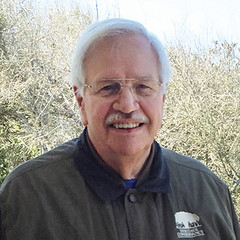 I currently serve as President of the American Numismatic Society. I was the editor of the award-winning Colonial Coin Collectors Club (C4) Newsletter for over 10 years
(retiring in 2016). I believe in the adage “buy the book first,” and have built an extensive numismatic library. My primary collecting interest is in pre-Federal coinage and colonial
medals, and I have authored three books dealing with these topics. I am a member of ANS, NBS, MCA, C4, TAMS, EAC, and ANA.
I currently serve as President of the American Numismatic Society. I was the editor of the award-winning Colonial Coin Collectors Club (C4) Newsletter for over 10 years
(retiring in 2016). I believe in the adage “buy the book first,” and have built an extensive numismatic library. My primary collecting interest is in pre-Federal coinage and colonial
medals, and I have authored three books dealing with these topics. I am a member of ANS, NBS, MCA, C4, TAMS, EAC, and ANA.
W. David Perkins
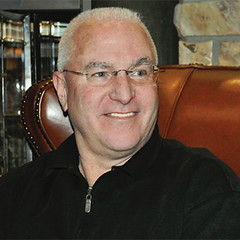 W. David Perkins is a longtime collector and researcher of the early United States silver dollars 1794-1803. Dave also collects Civil War Store Cards, tokens and Numismatic
Literature, including books, catalogs and documents pertaining to the great early silver dollar collections and collectors. His interest in Civil War Store Cards started with a discovery that
his great-great-grandfather issued two Detroit, Michigan Civil War tokens in 1863.
W. David Perkins is a longtime collector and researcher of the early United States silver dollars 1794-1803. Dave also collects Civil War Store Cards, tokens and Numismatic
Literature, including books, catalogs and documents pertaining to the great early silver dollar collections and collectors. His interest in Civil War Store Cards started with a discovery that
his great-great-grandfather issued two Detroit, Michigan Civil War tokens in 1863.
Dave was a consultant to Bowers & Merena in the cataloging of the Eliasberg early silver dollars and with Heritage Auctions for the Eric P. Newman early quarters and dollars, and has cataloged and consulted on early dollars and other coins and tokens for a number of numismatic auction firms. He has spoken on the early dollars at a number of ANA Numismatic Theatres and has taught a class on the dollars at the ANA Summer Conference. Dave has also been a contributor to a number of numismatic books over the years.
Dave is a past Secretary / Treasurer of NBS. In addition to NBS, Dave is a member of numerous numismatic organizations and clubs including the ANA, ANS, JRCS (LM), NLG, EAC, TAMS, CWTS (LM) and others. Dave is an officer and is Treasurer of the John Reich Collector’s Society. He has authored dozens of articles for a wide variety of publications including the The Asylum, John Reich Journal, Coin World, TAMS Journal, Civil War Token Journal, The Gobrecht Journal, NOW News and Talkin’ Tokens. His articles have won literary awards from NLG, JRCS, CWTS, TAMS, NTCA and NOW.
Bruce Wonder
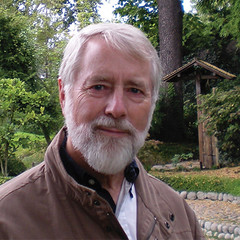 I am a retired professor of business management, having taught for 38 years—first at the University of Minnesota, then at Chico State, and finally at Western Washington University where I
also served as Chair of the Department of Management for 24 years. A coin collector since 1954, I have been a “vest-pocket” world coin dealer since 1982 with an emphasis on the coins of
early modern Europe. While my numismatic library is decidedly eclectic, my special interest is in antiquarian texts and, in particular, in the first half century of numismatic literature, i.e.,
from 1514 to the 1560s. I have been a NBS member for about 15 years.
I am a retired professor of business management, having taught for 38 years—first at the University of Minnesota, then at Chico State, and finally at Western Washington University where I
also served as Chair of the Department of Management for 24 years. A coin collector since 1954, I have been a “vest-pocket” world coin dealer since 1982 with an emphasis on the coins of
early modern Europe. While my numismatic library is decidedly eclectic, my special interest is in antiquarian texts and, in particular, in the first half century of numismatic literature, i.e.,
from 1514 to the 1560s. I have been a NBS member for about 15 years.
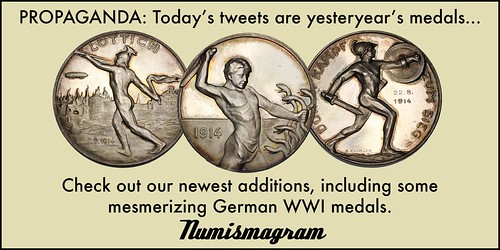
KOLBE & FANNING BUY OR BID SALE CLOSES JUNE 3, 2017
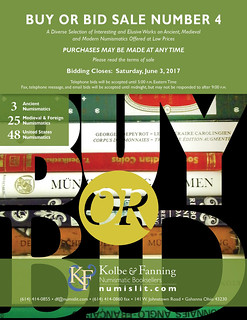 Kolbe & Fanning Numismatic Booksellers have announced their fourth “Buy or Bid Sale,” which begins now and will close on Saturday, June 3. The sale focuses on modestly priced books, giving
collectors an opportunity to add to their libraries at minimal cost.
Kolbe & Fanning Numismatic Booksellers have announced their fourth “Buy or Bid Sale,” which begins now and will close on Saturday, June 3. The sale focuses on modestly priced books, giving
collectors an opportunity to add to their libraries at minimal cost.
There will be no printed catalogue. The PDF catalogue is available now for downloading from the Kolbe & Fanning website at numislit.com.
As the name of the sale suggests, customers may bid on items they wish to acquire or buy them outright at the published price. The Terms of Sale will give full instructions on how to participate: please read it carefully.
The sale includes over 1200 works on ancient, medieval and modern coins, as well as general works, periodicals and sale catalogues. “Buy” prices have been kept low to promote sales. To further encourage participation, the firm is offering free domestic shipping to bidders spending at least $500; there will also be no packing and processing fee for this sale. Again, please read the Terms of Sale before participating.
If you have any questions about the sale, please write the firm at orders@numislit.com.
To read the complete catalog, see:
https://www.numislit.com/dl.php?file=/images/upload/kolbefanningbob4.pdf&type=pdf
NEW BOOK: MEGA RED 3RD EDITION
New 3rd Edition of MEGA RED Features Great Depression Hobo Nickels
 The third edition of MEGA RED (the Deluxe Edition of the Guide Book of United States Coins) officially debuted at the Whitman Coin and Collectibles Baltimore Expo, March 30, 2017,
and now is available nationwide. Among the book’s special features is a nine-page full-color appendix on hobo nickels.
The third edition of MEGA RED (the Deluxe Edition of the Guide Book of United States Coins) officially debuted at the Whitman Coin and Collectibles Baltimore Expo, March 30, 2017,
and now is available nationwide. Among the book’s special features is a nine-page full-color appendix on hobo nickels.
A hobo nickel is a Buffalo nickel with one or both sides altered by someone outside the Mint to make it look like another image. Often the Indian would be carved into a bearded man wearing a bowler hat, or the buffalo into a donkey, or (turned sideways) a man carrying a knapsack; sometimes political or social messages would be added. This form of folk art was popular in the 1910s through the 1940s, reaching its height during the 1930s Great Depression. Hoboes would engrave miniature works of art to sell or trade for a ride on a train, a meal, clothing, or a night’s lodging. Hobo nickels are very collectible. The Money Museum of the American Numismatic Association displays a collection of the coins, and active hobbyists convene in the Original Hobo Nickel Society (OHNS, online at www.hobonickels.org). In 2014 an example featuring both obverse and reverse carvings, graded as “Superior,” sold at auction for more than $22,000.
 Mega Red’s richly illustrated appendix pictures dozens of hobo nickels from the Classic, Later Classic, and Modern eras, with enlarged photographs. It references the research of
numismatists including Stephen Alpert, Marc Banks, Arturo DelFavero, Don Farnsworth, Bill Fivaz, Gail Kraljevich, and Del Romines. Each level of the grading system for hobo nickels (Superior, Above
Average, Average, Below Average, and Crude) is illustrated with examples. Included are hobo nickels created by the most famous carvers of the Great Depression, Bertram “Bert” Wiegand and his protégé
George Washington “Bo” Hughes, as well as artists whose real names are lost to history but whose styles are identifiable: Peanut Ear, Traveler, Rough Beard, and others. The works of well-known modern
engravers are also discussed: Ron Landis, Joe Paonessa, Alex Ostrogradsky, Howard Thomas, Chad Smith, Keith Pedersen, John Schipp, and Aleksey Saburov. And the appendix includes a feature on the only
Classic-era hobo nickel carver of whom a confirmed photograph exists: William Sharples (1902–1971), a tool and die engraver from New Jersey.
Mega Red’s richly illustrated appendix pictures dozens of hobo nickels from the Classic, Later Classic, and Modern eras, with enlarged photographs. It references the research of
numismatists including Stephen Alpert, Marc Banks, Arturo DelFavero, Don Farnsworth, Bill Fivaz, Gail Kraljevich, and Del Romines. Each level of the grading system for hobo nickels (Superior, Above
Average, Average, Below Average, and Crude) is illustrated with examples. Included are hobo nickels created by the most famous carvers of the Great Depression, Bertram “Bert” Wiegand and his protégé
George Washington “Bo” Hughes, as well as artists whose real names are lost to history but whose styles are identifiable: Peanut Ear, Traveler, Rough Beard, and others. The works of well-known modern
engravers are also discussed: Ron Landis, Joe Paonessa, Alex Ostrogradsky, Howard Thomas, Chad Smith, Keith Pedersen, John Schipp, and Aleksey Saburov. And the appendix includes a feature on the only
Classic-era hobo nickel carver of whom a confirmed photograph exists: William Sharples (1902–1971), a tool and die engraver from New Jersey.
Billed as the “biggest, most useful Red Book ever,” MEGA RED measures 7 x 10 inches and has 1,040 more pages than the regular edition. The larger size and increased page count combined make MEGA RED five times bigger than the regular-edition Red Book. It prices 8,200 items in up to 13 grades each, with 48,000 individual values and 15,400 auction records covering circulated, Mint State, and Proof coinage. The book is illustrated with 7,000 images, including 2,434 that are new to the third edition.
MEGA RED retails for $49.95 and is available online (including at Whitman.com) and from booksellers and hobby shops nationwide. Whitman Publishing is the Official Supplier of the ANA, and Association members receive a 10% discount off all purchases.
MEGA RED: A Guide Book of United States Coins, Deluxe Edition, 3rd edition
ISBN 0794845096
1,054 pages, full color
By R.S. Yeoman; senior editor Kenneth Bressett; research editor Q. David Bowers; valuations editor Jeff Garrett
$49.95 retail
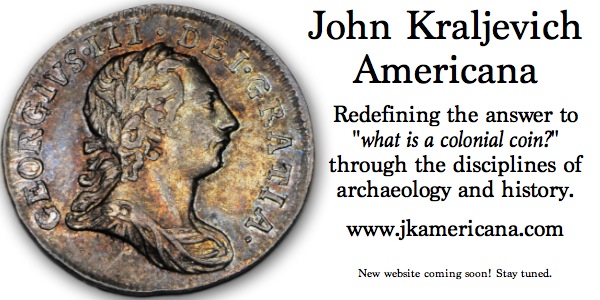
NEW BOOK: THE SS GAIRSOPPA SILVER TREASURE
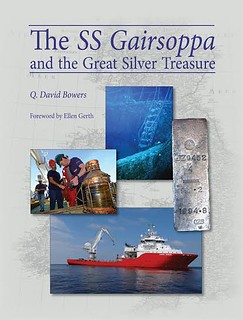 In his richly illustrated new book The SS Gairsoppa and the Great Silver Treasure, Q. David Bowers explores the cultural scene and political and military developments that led up to
the Second World War. Bowers, one of America’s preeminent historians, starts with the aftermath of the world conflict of 1914 to 1918. He colorfully describes the fabric of life in the United States
and international events through the 1920s and 1930s. Then: the eruption of fresh hostilities in 1939 and immersion in a new global war. Ultimately Bowers’s focus is the 1941 maritime loss of a
massive shipment of silver, sent to the ocean floor by a German submarine. A single event in a sprawling conflict—but one with cultural connections going back to 1919 and only recently emerging with
new discoveries. The wartime treasure, considered lost for more than 70 years, has been brought up from the depths of the cold North Atlantic Sea.
In his richly illustrated new book The SS Gairsoppa and the Great Silver Treasure, Q. David Bowers explores the cultural scene and political and military developments that led up to
the Second World War. Bowers, one of America’s preeminent historians, starts with the aftermath of the world conflict of 1914 to 1918. He colorfully describes the fabric of life in the United States
and international events through the 1920s and 1930s. Then: the eruption of fresh hostilities in 1939 and immersion in a new global war. Ultimately Bowers’s focus is the 1941 maritime loss of a
massive shipment of silver, sent to the ocean floor by a German submarine. A single event in a sprawling conflict—but one with cultural connections going back to 1919 and only recently emerging with
new discoveries. The wartime treasure, considered lost for more than 70 years, has been brought up from the depths of the cold North Atlantic Sea.

The British merchant steamer SS Gairsoppa was launched in the wake of the Great War, served commercial shipping for a generation, then was brought into convoy service after Britain declared war on Nazi Germany in 1939. In December 1940 she left Calcutta, India, en route to England with a 7,000-ton cargo, including some 200 tons (7,000,000 ounces) of silver for the British war effort. As she left Freetown, Sierra Leone, in January 1941, her convoy was a ragtag flotilla of merchant vessels with no military escort. They may have been aiming to meet up with another group protected by two warships.
Bowers relates the ill-fated final adventure of the Gairsoppa as her convoy was assailed by violent weather and as British warships that might have aided them were torpedoed by German U-boats and bombed by German airplanes. She finally was separated from the rest of her group, weighed down by heavy cargo and dangerously low on fuel—a choice target for a marauding submarine. The Gaisoppa’s fate was sealed by a torpedo from the U-101. Machine-gun fire killed many of the men who survived her sinking.
Bowers gives his readers plenty of military detail to chew on. He relays the account of the ship’s destruction, the escape of 31 men on a lifeboat, and the sad fate of those briefly lucky ones. He lays out the history of Germany’s U-boat program, and specifically of the U-101, which sank not only the huge amount of cargo in the Gairsoppa but 10 times as much through the course of the war. It’s no wonder that Winston Churchill later wrote, as Bowers recounts, “The only thing that ever really frightened me during the war was the U-boat peril.”
Every time a nation goes to war great treasures are lost—commercial goods being among the least of them, by the measure of human affairs and in the painful experience of families who endure the ultimate sacrifice. Bowers focuses not only on the disappearance of the silver ingots, iron, Indian tea, and other resources that made up the Gairsoppa’s 7,000 tons of cargo; he names every member of the ship’s 80-plus crew members. The youngest was a 17-year-old cadet.
In 1919, when the Gairsoppa was first launched, most of her wartime European officers and crew, and many of her Indian merchant seamen, either were young children or hadn’t even been born yet. They came of age in the between-wars era that Bowers describes with great charm and vibrant color. In 1940 these men undertook a dangerous voyage in a commercial ship on the open seas, amazingly unprotected from their enemies, carrying what we can say in hindsight was too much weight. In 1941 only a single member of the Gairsoppa’s human manifest survived the ship’s destruction.
As a historian Q. David Bowers is known for, among other specialties, his research into shipwrecks and sunken treasure. This puts the Gairsoppa and her cargo of silver squarely within his wheelhouse. Decades after the war’s end, the wreck of the Gairsoppa was pinpointed, nearly 5,000 meters below the waves, deeper than the Titanic. Bowers recounts how, starting in 2012, the deep-sea salvage team of Odyssey Marine Exploration brought up artifacts including some 110 tons of silver, making it the largest recovery of precious metal in history. Ellen Gerth, curator at Odyssey at the time, provided many details. Numismatists—students of coins and other money, who know Bowers well as the award-winning author of many standard references in that field—will be particularly interested in the 400-plus recovered silver ingots, each one 99.9 percent fine, serial-numbered, stamped with the mark of His Majesty King George VI’s Bombay Mint in India.
The salvage crew of Odyssey Marine Exploration lowered to the Gairsoppa’s submerged deck a large commemorative plaque with the names of the ship’s lost crewmen. “May your memory live,” it reads, “and may your story be told.” Thanks to Q. David Bowers, their story has been told, and told well.
SS Gairsoppa and the Great Silver Treasure
Format: Hardbound
Pages: 79
Price: $19.95
Order from:
Monaco Rare Coins
4900 Birch St.
Newport Beach, CA 92660
email: wholesale@monacorarecoins.com
To read the complete article, see:
The SS Gairsoppa and the Great Silver Treasure
(http://news.coinupdate.com/the-ss-gairsoppa-and-the-great-silver-treasure/)
NEW BOOK: HIGHFILL SILVER DOLLARS 2017 EDITION
 The print version of the two-volume hardcover 2017 edition of The Comprehensive U.S. Silver Dollar Encyclopedia by John W. Highfill at 1,566 pages is double the size of the inaugural
1992 reference.
The print version of the two-volume hardcover 2017 edition of The Comprehensive U.S. Silver Dollar Encyclopedia by John W. Highfill at 1,566 pages is double the size of the inaugural
1992 reference.
Collectors, dealers and researchers also have the option to acquire a searchable, digital e-book edition that is stored on a credit-card-sized storage medium that can be inserted into computer devices. Information in the e-book is updated every 90 days, according to Highfill, and the updated versions made available for purchase.
The pages in the print edition are evenly divided between the two volumes and encompass more than 3 million words in 100 chapters.
The reference includes thousands of charts and graphs, as well as images of both toned and brilliant silver dollars. Highfill covers the silver dollar collecting field by series, starting with the Flowing Hair coins, followed by Draped Bust issues, Gobrecht dollars, Seated Liberty dollars, Morgan dollars, Trade dollars and Peace dollars.
The encyclopedia covers the history behind each series, including authorizing legislation and the production of each series at multiple U.S. Mint facilities. The book also features extensive coverage and accounts of coin hoards, with contributions from leading professional numismatists spanning the hobby over several decades. It also includes dedicated information to varieties and rarities within each series, as well as pricing details, auction performances, and pedigree information.
The suggested retail price for the two-volume book is $395 and the e-book is priced at $99. For a limited time, Highfill is offering the print book at an introductory price of $299.
The printed and e-book versions are available through Amazon.com, Barnes and Noble, eBay Books, and wherever hobby books are sold.
The books are also available as personal signed copies and e-books from John Highfill, Highfill Press LLC, P.O. Box 25, Broken Arrow, OK &4013-0025.
Telephone Highfill at 918-254-8931 or 918-814-8054.
To read the complete article, see:
The Comprehensive U.S. Silver Dollar Encyclopedia available in printed, digital
editions (http://www.coinworld.com/news/us-coins/2017/05/silver-dollar-specialist-updates-massive-reference.all.html)

RUSS SEARS (1942-2017)
I was very sorry to learn Friday that E-Sylum reader and contributor Russ Sears of Maryland passed away. His wife Jane provided his portrait and a link to his online obituary.
An active Baltimore historian, Russ wrote the following in the Foreword of his latest book: "Over the years I have presented historical talks to over fifteen local and national/international organizations. Items from my collections have been exhibited at Fort McHenry National Monument and Historic Shrine, The Carroll Museums, Clifton Mansion, Baltimore County libraries and The Fire Museum of Maryland."
Russ has been active in the Civil War Token Society, served as Vice President and President of the Maryland Token and Maryland Society, and Editor of the Maryland TAMS Journal. -Editor
 On May 18, 2017, Russ Sears, U.S. Army Veteran, of Cub Hill, beloved husband of Mary Jane (nee Wildberger) for 49 years; devoted father of David A. Sears.
On May 18, 2017, Russ Sears, U.S. Army Veteran, of Cub Hill, beloved husband of Mary Jane (nee Wildberger) for 49 years; devoted father of David A. Sears.
Family and friends will celebrate Russ’s life at the family owned Evans Funeral Chapel and Cremation Services – Parkville, 8800 Harford Rd. on Thursday, May 25, 2017 from 3-5 & 7-9 PM where a memorial service will begin at 8 PM. Interment Private. In lieu of flowers, memorial contributions in Russ’s name may be made to American Cancer Society, 405 Williams Court Suite 120, Baltimore, Maryland 21220.
To read the complete obituary, see:
Russ Sears | 1942 - 2017 | Obituary (http://www.evansfuneralchapel.com/obituary/4235336)
I wasn't terribly surprised when my phone rang Friday evening and I saw it was a call from Russ. I thought he might want to add something to the item I'd put in this issue of The E-Sylum. I'd sent him a draft by email just a few hours earlier. But it was his wife Jane calling with the news.
Russ had sent the following to me last week, but I'd run out of time to put it in. So here's his final contribution. Thanks, Russ. You will be missed. -Editor
Another Diaper Die Example
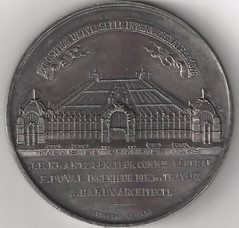
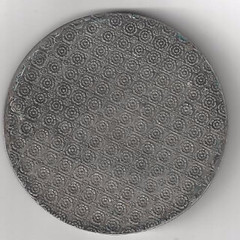
In his May 7, 2017 Vocabulary article, Dick Johnson discussed the "diaper die":
Instead of a blank die early die makers occasionally used a die with a substitute design when proving a new die when its mated die was not available. Each die maker had his own diaper die design.
Russ Sears writes:
Like you, I had not heard of the term 'diaper'. But, I have seen a medal as described. Attached is my medal from the 1878 Paris Universal Exposition, different from the one in The E-Sylum.


To read the earlier E-Sylum articles, see:
VOCABULARY TERM: DIAPER (http://www.coinbooks.org/v20/esylum_v20n19a11.html)
BARRY JABLON AND RUSS SEARS (http://www.coinbooks.org/esylum_v09n36a27.html)
MORE ON THE U.S. SHIP/FRIGATE CONSTITUTION (http://www.coinbooks.org/esylum_v12n38a20.html)
RUSS SEARS VISITS MARYLAND MEDAL MAKER J. JENKINS SONS (http://www.coinbooks.org/esylum_v13n34a16.html)
JOHNS HOPKINS MEDALS (http://www.coinbooks.org/esylum_v18n39a24.html)
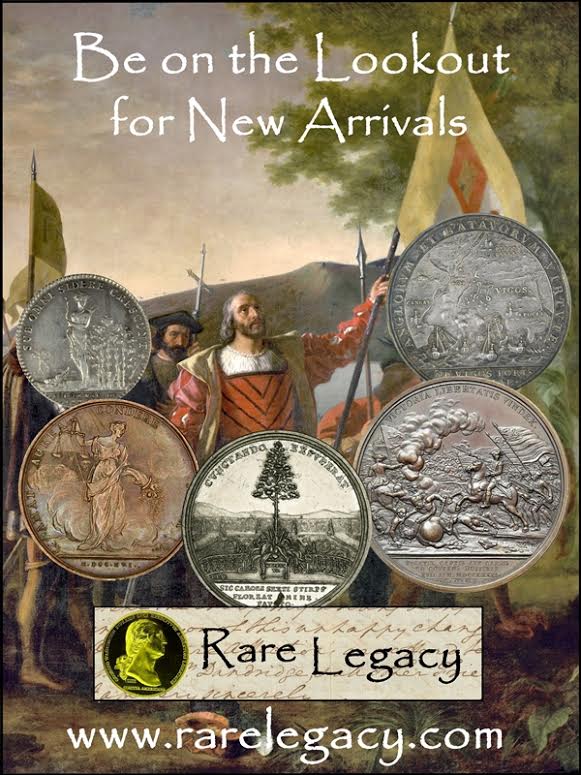
CATHERINE BULLOWA-MOORE (1919-2017)
From a May 17, 2017 email to members of the Professional Numismatists Guild (PNG):
We are deeply saddened to inform you of the passing of a true icon, Catherine Bullowa-Moore. She was Life Member number 3, one of the founding PNG members when the organization was formally launched in 1954. Catherine was a good friend and mentor to many in the hobby and profession. She received the first PNG Lifetime Achievement Award in 1997, and for her decades of goodwill she received the PNG's Art Kagin Ambassador Award in 2013. Catherine passed peacefully in her sleep on Monday night, at the age of 97. She will be missed.
PNG Living History: Catherine Bullowa, March 8, 2008 (www.youtube.com/watch?v=D2ZjAftrFaQ) -Editor
Harvey Stack writes:
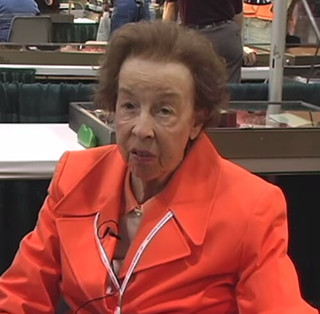 I met Catherine in the early days of my numismatic career. It was in 1947 that I traveled to Philadelphia to buy a collection and stopped into the numismatic shop of David M. Bullowa on
18th Street, I met Catherine then who was working for David and learned a few years later that they married.
I met Catherine in the early days of my numismatic career. It was in 1947 that I traveled to Philadelphia to buy a collection and stopped into the numismatic shop of David M. Bullowa on
18th Street, I met Catherine then who was working for David and learned a few years later that they married.
David died in 1953 and Catherine decided to continue the numismatic business and eventually changed the name to The Coin Hunter. She was a well taught and active numismatist and became friends to many of the coin collectors in Philadelphia. She became active in many of the clubs in the Pennsylvania area, as well as those in New Jersey and New York. She loved the hobby and the people who were active in coin collecting.
She was active in the American Numismatic Association and attend many of the meetings of the American Numismatic Society in New York City. She was highly respected by her clients and collegues. She was active in many of the shows about the country and would man her table with great enthusiasm for those who stopped by.
She knew a great deal about numismatics, having been initially trained by her husband when she worked with him for many years, and had the opportunity of meeting and learning from the core of great numismatists who lived in or near Philadelphia, As she got older she became somewhat frail, but her memory and knowledge of numismatics were with her till the day she passed away. All who knew her admired her skills and personality, and once you met her, she always remembered you, and would tell a story about the early days when coins were considered a "fun hobby."
We all will miss her greatly, but she left a legacy for woman in numismatics which is envied by all
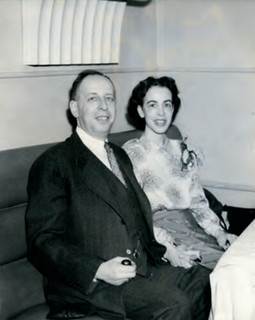

Catherine with David Bullowa c1953; at 2011 NY International
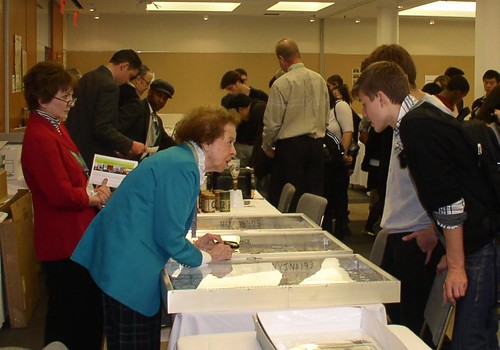
2012 Wall Street Bourse (Joy Moore is in red behind Catherine)
By James A. Simek, PNG Secretary
Catherine Bullowa-Moore, a very highly respected Philadelphia coin dealer for six and one-half decades, passed away peacefully May 15, 2017. She was 97 years of age and was originally from Larchmont, New York. She was likable, charming, engaging and very interested in educating people about the joys of numismatics. She was particularly fond of talking to youngsters about coins because she felt they represented the future of the hobby.
I first met Catherine in 1966, I believe, at a coin show in downtown Chicago. I was a teenager with very little money to spend, and I let her know that. She graciously spent time visiting with me and even let me have a coin on “memo” since I did not have enough money with me to pay for it (at the time I did not even know what “memo” meant!). I was taken aback, since we had just met and did not really know each other, but she said “that’s OK, I trust you.” That left an indelible mark and led to a friendship that has endured for more than half a century. She is one of the reasons I am in this profession today.
After marrying David Bullowa, one of America’s premier professional numismatists, Catherine was thrust into the rare coin business when David died unexpectedly in October 1953 after only 1-1/2 years of marriage. Although approached by numerous dealers who wanted to purchase the business name and location, Catherine was determined to make a career of it herself. “Determined” is a good word to describe Catherine. She was independent, strong-willed and extremely capable and was admired by many for having these traits.
She had acquired a love of coins from her late husband and, in his memory, decided to continue the business. Keep in mind that, at the time, there were only a handful of female coin dealers in the entire country so this presented quite a challenge for the young lady who had majored in zoology at Connecticut College.
Catherine loved to read and made good use of David’s extensive numismatic library. She studied not only United States coins and currency, but foreign and ancient coins as well. It was not long before she was a self-taught expert in several aspects of numismatics.
In 1959, Catherine married Earl E Moore, an autographs and manuscripts specialist. Their union was to last 41 years. They were frequent attendees at coin shows and conventions throughout the country and both of them enjoyed the camaraderie and interactions with old friends that these opportunities afforded.
Through the years, Catherine held membership in numerous professional and hobby- related organizations. Among them were the American Numismatic Society (ANS) of which she was a Life Fellow and to which she contributed generously; the Royal Numismatic Society (RNS) of which she was a Fellow; the International Association of Professional Numismatists (IAPN); the American Numismatic Association (ANA) in which she held Life Membership #355; and the American Society of Appraisers (ASA) where she had Senior Member status. She was also a founding member of the Professional Numismatists Guild (PNG), and one of only a handful of individuals to have been given Life Member status (#3) by the organization.
Catherine received many awards and accolades throughout her illustrious career, and one she was quite pleased to receive was the PNG’s inaugural Lifetime Achievement Award in 1997. She also received their Art Kagin Numismatic Ambassador Award in 2013.
One achievement of which she was particularly proud was to have been chosen in 1965 as a member of the United States Assay Commission. Names were submitted by the Director of the Mint to the White House where the final choices were made. Members would check random samples of the previous year’s coinage for weight and purity and membership in the Commission carried with it a great deal of prestige. She also was a member of the Old Time Assay Commissioners’ Society and enjoyed that immensely.
Catherine’s rich legacy and fond memories remain with countless people she has come in contact with throughout her long and illustrious career in numismatics. She will be greatly missed by her family, as well as by numerous friends and associates.
Catherine Bullowa was a class act, and a tribute to her profession. She always had time to talk coins with anyone who stopped by, and because of her many years in the profession, she had some fascinating stories to tell.
I recall in one of her many 'CoinHunter' mail bid sales, in June of 1993, she had a significant listing of half dimes (approximately 150 pieces), listed as "Wonder Half Dimes". I was the successful bidder on a few of these coins, particularly an AU-55 1832 LM-6/V11, listed at the time (before publication of the Logan/McCloskey reference) as an R4, and listed as an R6 by Jules Reiver in 1986, and a condition census piece to this day.
I was curious about who might have been the consignor of these half dimes, wondering if they might be remnants of the long-lost Daniel W. Valentine collection. I once asked her who might have been the consignor, and being the professional she was, she declined to reveal the consignor's identity. She then asked me why I wanted to know, and I told her that I wondered if they had any connection to the Valentine collection. She smiled, and said that she could provide me with some interesting information about the consignor and the Valentine collection.
She said that her late first husband, David Bullowa, knew the consignor well, and the consignor was a friend of Valentines, and they often traded examples of half dimes. She was confident that some, perhaps many, of the coins in this consignment, were once owned by Dr. Valentine. She was intrigued by my interest in the history of the coins, and gave me as much information about them as her professional ethics would allow. I still have several pages of notes on her comments about the coins and consignor.
I will miss her smiling face, her candor, and her many stories about the history of the hobby. She will be sadly missed by all who knew her. May she rest in peace.
To read the complete discussion thread, see:
Catherine Bullowa Passed Away
(https://forums.collectors.com/discussion/981124/catherine-bullowa-passed-away)
The year was 1953 when Catherine E. Bullowa, ASA began the process to become Accredited Senior Appraiser. She had gained a love and admiration for coin collecting from her late husband David Bullowa who owned a shop in Philadelphia, Pennsylvania. When David passed away in 1953, Catherine had a choice: sell the shop or run the business herself. She decided to move forward with both her love of coins and the memory of David. “I took over. Started. Tried. And it worked! I’ve been doing it ever since.”
Catherine studied at Connecticut College before embarking on her appraising career. And the major? Not one you’d expect. “I was a Zoology major at Connecticut College and graduate din 1941. That’s how I knew how to grade coins, from looking at things through a microscope and a magnifying glass.”
Her most memorable sale was an unlikely coin she bought off of a collector in 1965. She had purchased the entire collection and sold them off, piece by piece, but for some reason kept one coin. In 2004, the coin sold at auction for a little over $1M. “I was ready to faint. I didn’t even know how to write a million! But Ron Guth was the auctioneer and he helped me.”
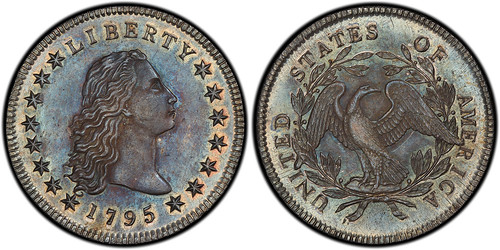
Ron Guth writes:
Catherine Bullowa was one of my favorite people in the hobby. Circa 2005, when I was active as an auctioneer, Catherine invited me to Philadelphia to call a couple of her sales. Her daughter, Joy (who is also a fine lady) was assisting Catherine and the two of them were a real pleasure to work with.
Catherine's sales were smallish affairs with a nice mix of collector coins and a few rarities. However, her December 2005 was something very different. Catherine decided to pull out a few of her special coins and offer them for sale. The highlight of the auction was a 1795 Flowing Hair $1 (B-7, BB-18) in Gem condition. Catherine knew it was a special coin, but I think even she was surprised when most of the big players began showing up for lot viewing.
I remember sitting in her office with Chris Napolitano, where we spent quite some time examining the coin, discussing it's merits, and guessing it's worth. I can't remember the opening bid when the coin came up for sale, but it was substantial and it kept on climbing. I'm relying on ancient memory here, but I believe the bidding ended up between Don Ketterling and John Gervasoni. I believe the lot was won on Don's cut bid of $1.1 million, yielding a hammer price of $1,265,000.
Catherine was stunned, obviously very happy but also shaken. It was one of those surreal moments when the ultimate buyer (who turned out to be D. Brent Pogue) met the ultimate coin owned by a very special and deserving seller. I don't think Catherine, even in her wildest dreams, ever expected the coin to sell for so much, but it could not have happened to a nicer person.
After the coin sold, we took a short break to make sure everything was recorded properly and to revel in the moment. At the end of the sale, Catherine presented me with an unexpected gift - a lime-green Tommy Bahama shirt. For my part in selling the coin, I received my usual fee of $1 per lot, a new item for my wardrobe, and one of the greatest memories of my career. I'll always remember Catherine's beaming, incredulous face.
To read the complete articles, see:
A Century of Living History: Catherine Bullowa, ASA (http://www.appraisersnewsroom.org/?p=1113)
Icon of American numismatics passed away
(http://www.coinsweekly.com/en/News/Icon-of-American-numismatics-passed-away/4?&id=4712)
To read the Pogue sale lot description, see: The D. Brent Pogue Collection, Part II Lot #2042 (http://old.stacksbowers.com/BrowseAuctions/LotArchive.aspx?AuctionID=6073&Lot=2042)
To read her online obituary, see:
Catherine B. Moore
(http://www.legacy.com/obituaries/name/catherine-moore-obituary?pid=1000000185407800)
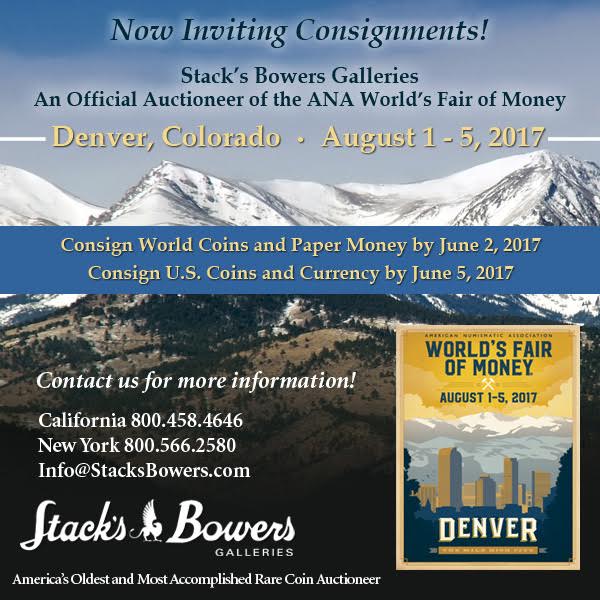
DIGITIZED: AMERICAN NUMISMATIC RARITIES CATALOGS
American Numismatic Rarities Auction Sale Catalogs on Newman Portal
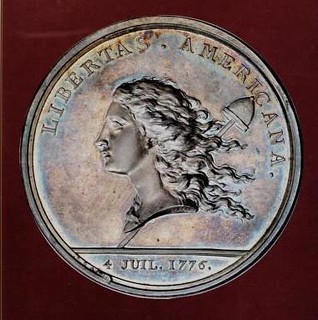 Following the sale of Bowers & Merena Galleries to Collectors Universe in 2000, several of the old Bowers & Merena firm came together to create American Numismatic Rarities (ANR), which
began presenting auction sales in 2003. The firm conducted 25 sales between 2003 and 2006 and then merged with Stack’s, today known as Stack’s Bowers (the Bowers name being reacquired in 2011).
Following the sale of Bowers & Merena Galleries to Collectors Universe in 2000, several of the old Bowers & Merena firm came together to create American Numismatic Rarities (ANR), which
began presenting auction sales in 2003. The firm conducted 25 sales between 2003 and 2006 and then merged with Stack’s, today known as Stack’s Bowers (the Bowers name being reacquired in 2011).
While the naming has come full circle, this set of 25 catalogs contains some of the best American material offered in the mid-2000s. These are now scanned and available on the Newman Portal. Especially memorable in this run are the smaller sales which presented boutique collections. Among them are Oliver Jung (107 lots of U.S. type), and the Cardinal collection (61 lots, primarily early U.S. dollars), both of which hammered at over $5 million. The Newman Portal acknowledges Brian Kendrella of Stack’s Bowers for his assistance with this project.
Illustrated: Libertas Americana silver medal from the Cardinal collection (ANR, June 2005, lot 3, ex. Bass, realized $115,000).
Link to ANR auction sale catalogs on NNP:
https://nnp.wustl.edu/library/auctioncompanydetail/1
HAPPY BIRTHDAY #106, ERIC P. NEWMAN
Maureen and Stu Levine
Maureen and Stu Levine write:
Best wishes for a very happy birthday to Eric, our dear friend and mentor.
George Kolbe
Numismatic literature dealer George Kolbe writes:
Happy Birthday, Eric!
Jeff Garrett
American Numismatic Association President Jeff Garrett writes:
Happy birthday Eric, you are an inspiration to us all! Thank you so much for your enduring contributions to the hobby we all love so much.
Joel Orosz
Joel Orosz writes:
As Eric's 106th birthday approaches, it occurs to me that it is a shame that the American Numismatic Society no longer has its own building, so that an oversight could be corrected, In the old ANS building at Audubon Terrace in New York City, the names of the world's most scholarly numismatists were carved into the frieze just under the roof line. The only American included in this roster was Sylvester Sage Crosby; This made sense early in the 20th century, but a century later, any such list of the immortals would have to include Eric P. Newman,
Jeff Reichenberger
Jeff Reichenberger writes:
It was only a blip in your Numismatic life. Back when you were merely 99. You welcomed me and helped me research and write a project in collaborative effort. A blip for you, but a major unforgettable experience for me. THANK YOU for that moment in my Numismatic life! Your generosity in sharing your fun, your hobby, your curiosity, your research, your passion - has made our hobby so much more fun and accessible to the entire Numismatic community. Godspeed dear man, live long-er and prosper.
Roger Siboni
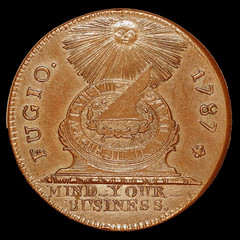
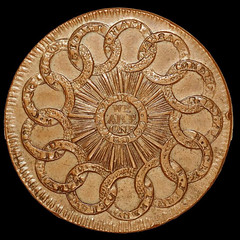
Courtesy Roger Siboni
Roger Siboni writes:
Happy 106th! 106, man o man!
I will never forget coming home from the EAC in St. Louis held in conjunction with Opening of the Newman Money Museum to host my daughter and her new freshman classmate Liberty from MIT. It took me (us) about a half an hour to finally realize her "coin collecting Uncle Eric" who made the "best root beer floats on Earth" each summer was the same Eric Newman I just returned from celebrating the opening of the Money Museum with. Such a small world. We were all stunned!
Eric, thank you so much for igniting my love affair with Numismatics, sending me on my quest to collect every variety of James II 1/24 Reals, Machin's Mills coppers, Swedish Plate Money and a library to immerse myself in the love!
Dave Bowers
Dave Bowers writes:
What to say about Eric P. Newman? Well, given the proverbial soapbox to stand on I could spend an hour telling of Eric, at which time I would have to invite listeners to come back for more later!
In the mid-1950s I first interfaced with Eric. He was the ultimate source for reliable material about colonial and early American coins, one of my favorite series. After reading what S.S. Crosby said in Early American Coins, 1875, about Vermont coins and the mysterious Machin’s Mills, I was captivated. In asking around I learned that there were three other people interested in this secret mint—Ken Bressett, Walter Breen, and Eric.
In time we became occasional correspondents. For one reason or another he tapped me, as a dealer, for a source on market information as well as to various dealers he read about. Eric was not a frequent attendee of conventions. Most of these contacts were via telephone. Among early conversations I remember that he became very interested in the 1955 Doubled Die cent and we discussed that. Eric was very sharp regarding market values, often reminding me, “I am not a dealer, you know.” However his awareness of the market was superb.
We also talked a lot about business. Edison Brothers Stores was the family business. Shoe stores were conducted under the names of Baker (lower end), Burt (also lower end if I remember correctly), Leeds (medium scale), and Chandler’s. The marketing often involved placing several of these brands on the same city block, thereby creating a “shoe district.”
Eric visited me in California when I lived there and also in New Hampshire. I remember that one evening our entire conversation was about shoe manufacturing and retailing, how Brazil was a major source, and more. Edison Brothers Stores also went into non-shoe stores later, and I was told about them as they were rolled out. These were not a success.
Once Eric brought all of his spectacular early silver dollars to New Hampshire on a visit, for me to appraise. We were going out to dinner, and I said it was my policy never to have coins in the house, so let’s take them with us. He demurred and placed the National album pages under several sofa cushions!
When the Rittenhouse Society was formed in 1957 as a club for those interested in research, we decided to limit the age to 30. At our first formal breakfast meeting at the ANA Convention in Boston in 1960 we took stock of this, decided we could not possibly disqualify Eric, so that rule was dropped. Eric was in his 40s the time. At the next meeting we made him a member by unanimous acclamation.
Once when visiting Eric at his house in St. Louis he showed me his Wooton desk, a petite model. “I bet you can’t find the secret compartment,” he said. Forthwith I went to the desk and near the top front raised a secretly-hinged panel. “I have a Wooton desk, too,” I hastened to explain.
Eric was a purist—a rare species (but Emery May Holden Norweb and Harry W. Bass, Jr., were among others I have had the privilege to have as close friends). He could have written an essay on numismatic ethics, but never did.
In contrast, John J. Ford, Jr., also a fine friend of my from the 1950s onward, was a man of opportunity—for want of a better phrase. Eric viewed JJF as an opportunist and JJF viewed Eric as an expert with more credentials than he deserved.
The big break came in 1958 when F.C.C. Boyd died. Boyd and Eric were close on research matters, and a large part of his collection was on loan to Eric in St. Louis for study. JJF was also close to Boyd. At Boyd’s funeral cortege Eric rode with or near his widow Helen. Somehow, JJF persuaded Helen Boyd to sell him whatever he wanted from her late husband’s collection at the “generous offers” JJF said he would make. This involved the indignity of having Eric send back Boyd’s paper money so it could be added to Ford’s collection. Matters went from bad to worse.
I was close friends of both Eric and JJF but stayed away from rising to the challenge of making remarks when one talked about the other. Some years later I was with Eric at an ANA Convention (in later years he attended more shows), and JJF was giving a program. I suggested to Eric that it might be a good time to at least speak to JJF—for the first time in many years. He agreed. I then went to JJF and mentioned this. “Under no circumstances do I want him here,” or similar, was the comment.
Eric was highly and deservedly honored many ways—gaining the highest awards bestowed by the American Numismatic Society and the American Numismatic Association. Some years ago he was feted by the ANS at a dinner at the Explorers Club in New York City.
He and wife Evelyn traveled to just about every place imaginable. Once near Spitzbergen his crew had to be sure they would not be bothered by polar bears. On one trip he and Evelyn made overnight reservations in Mecca. Upon checking into the hotel he was informed that his wife, a non-Muslim woman, was not allowed. The Newmans packed up and left.
Eric was of great help to me in research over a long period of years and proofread and copy edited a number of my books, and wrote some forewords. He suggested the titles for my books on the 1804 dollar and the S.S. Central America treasure. I have 1,001 notes and anecdotes about Eric, all of them favorable. I’ll have to organize them someday. He is an American treasure.
In the meantime, Happy 106th!
Len Augsburger

Above: Brand secondary ledger #7 (1908-1909), the WASHINGTON PRESIDENT in gold is entry #46483.
Below: Newman’s handwritten inventory of half dollars in the Green collection. Included are many 1796 and 1797 pieces, the 1838-O, 1861 Confederate (four known), and 1792 WASHINGTON PRESIDENT in gold (unique).
Newman Numismatic Portal Project Coordinator Len Augsburger writes:
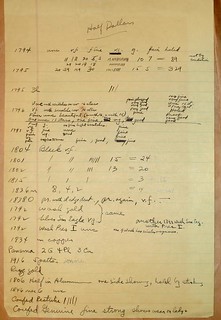 I can’t say this was found in honor of Eric, but the timing with his birthday is fortuitous. Eric’s favorite coin in his collection is the WASHINGTON PRESIDENT 1792 pattern in gold (Baker
20-b), which he acquired out of the Col. E. H. R. Green estate in the early 1940s. While searching the Virgil Brand ledgers from the ANS (recently digitized in cooperation with the Newman Portal),
Saul Teichman made an interesting discovery – this coin had passed through the Brand collection.
I can’t say this was found in honor of Eric, but the timing with his birthday is fortuitous. Eric’s favorite coin in his collection is the WASHINGTON PRESIDENT 1792 pattern in gold (Baker
20-b), which he acquired out of the Col. E. H. R. Green estate in the early 1940s. While searching the Virgil Brand ledgers from the ANS (recently digitized in cooperation with the Newman Portal),
Saul Teichman made an interesting discovery – this coin had passed through the Brand collection.
Previously published pedigrees can now be refined – the coin went from Parmelee to DeWitt Smith, then to Brand who purchased the Smith collection en bloc in 1908. Wayte Raymond acquired the piece for $2500 out the Brand estate, 6/27/1933, and in turn sold to Green. Thanks to Saul Teichman and Wayne Burt for furnishing the latest pedigree.
Heritage Auctions
The Gang at Heritage Auctions writes:
Happy 106th Birthday to you, Eric P. Newman
Thank you for all you have done for numismatics over these last eight decades. Thank you for your peerless research, relentless seeking and sharing of knowledge, and steadfast loyalty to the truth no matter the cost. Thank you for being a role model, mentor and friend to so many. Thank you for forming and preserving one of the most impressive numismatic cabinets of all time, and for making those treasures available to a new generation of collectors. And thank you for your generosity in establishing the Newman Numismatic Portal (nnp.wustl.edu), which will benefit our wonderful hobby for centuries to come.
From Mark Borckardt, Jim Halperin, Steve Ivy, and your many other friends and admirers at Heritage Auctions.
John Feigenbaum
John Feigenbaum writes:
Despite a lifetime spent in numismatics by both of us, I did not have the good fortune to meet you until 2014 – at our respective ages of 45 and 103! It was my good fortune because your generosity of knowledge, spirit and philanthropy have been the backbone of one of the most rewarding aspects of my numismatic career: the Newman Numismatic Portal. This amazing resource will empower future collectors and researchers.
On a personal note, our relationship has extended to my mother Lynn and son Benjamin (now a student at Washington University!), who both send their wishes for a happy and healthy 107th year on this planet. We are all much richer for time spent with you and your lovely wife Evelyn, of blessed memory.
Sincerely, John… with love from the entire Feigenbaum family
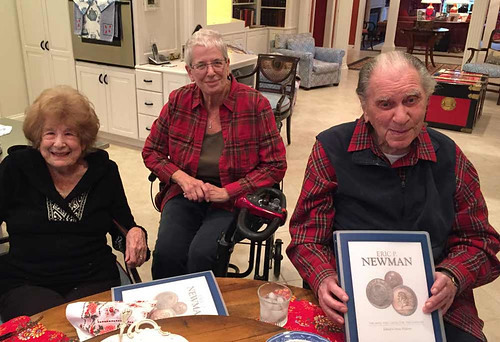
Evelyn and Eric Newman, with Lynn Feigenbaum, center
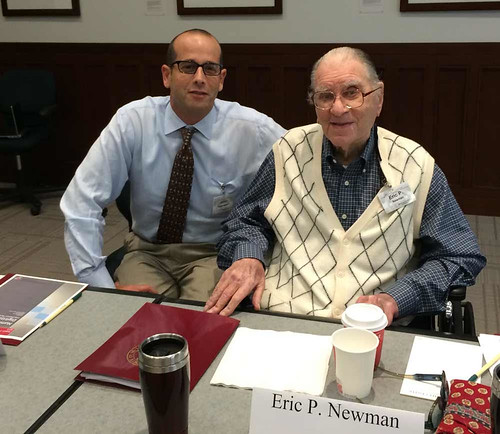
John Feigenbaum and Eric Newman
Ray Williams
Ray Williams of Trenton, NJ writes:
Happy Birthday Eric!
Congratulations on 106 years! Thank you for many decades of sharing your hobby passion with the numismatic community. You have directly or indirectly made a positive influence on millions of collectors through your research and publications. I am just one of them. I look forward to your current research being published.
Kellen Hoard
Kellen Hoard writes:
Dear Mr. Newman,
You are one of my role models. There is no doubt about that. Your promotion of the scholarly field of numismatics really connects with me; as a kid in a gifted program at my school, I often focus on the intellectual side of things. When you responded to a letter of mine last year, this helped me regain my interest in the hobby as a whole, and made me somewhat of a celebrity within my coin club. I think we all have something to learn from you and your kind, intelligent, benevolent actions.
So, to thank you for everything you have done for me (whether you knew it or not), I am forming the "Thanks to Eric Newman Group". Many numismatists owe many things to you. So, if you are one of these collectors who has been influenced by Mr. Newman, contact me and we can have a conversation about numismatics. It can be anything related to numismatics, any piece of advice for me, etc. I want to learn about the hobby I love from other knowledgeable collectors, and I believe this continues the legacy of learning that Eric Newman has promoted for decades. In the words of Benjamin Franklin, "Tell me and I forget. Teach me and I remember. Involve me and I learn."
W. David Perkins
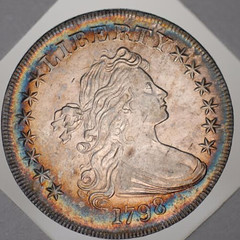

This beautiful Mint State 1798 B-31, BB-115 Silver Dollar was not part of Heritage Auctions sale of the Eric P. Newman Collection. Photo courtesy of W. David Perkins and Rory Rea.
W. David Perkins of Centennial, CO writes:
I’d like to add my, “Happy 106th Birthday Eric!” to the others in tonight’s issue of The E-Sylum.
If I recall correctly, I first started corresponding with Eric Newman in the second half of 1995. One of my long term research projects for the Early U.S. Silver Dollars 1794-1804 has been the Col. E.H.R. Green Collection of early dollars. I had been keeping a spreadsheet of every early dollar die marriage and coin I came across with the Col. Green pedigree. I think I had over 125 different early dollars recorded at this time.
In 1993, Q. David Bowers published his Silver Dollars and Trade Dollars of the United States A Complete Encyclopedia. The early dollars 1794 to 1804 were in Volume I of this large two volume set. As only a researcher might do, I went about “plate matching” all of the plate coins and what Bowers called “Notable Specimens” in this book to auction catalogs and other appearances of these coins to develop the pedigrees and learn more about the relative rarity of each die marriage. This amounted to over 1,000 coins that I had to plate match. Luckily the ANA Library was only an hour away... As of mid-1995, I was down to only 13 plate coins that I could not identify.
I then wrote Eric Newman asking questions about the Col. Green Collection, and also asked him if any of the plate coins in the Bowers book might be in his collection. His answer was something to the effect, “you’re the expert, you tell me!” I guess that I was being “screened (?).” I replied with a detailed one page summary of the coins I thought were his, might be his, etc. I also sent him my listing of the Col. Green Collection to date. I was “in.”
When I think of Eric Newman, one overriding memory is the two visits I had to St. Louis and the Newman museum to view and study the early dollars from his collection, and later the early dollars again along with his collection of the early U.S. Quarter Dollars 1796-1838 (around 2007).
When I first saw the Newman early dollar collection, the collection was stored in three brown Wayte Raymond coin boards and had likely not seen the light of day in decades. Each of the early dollars in his collection had been hand-picked from multiple examples of each date (including his 1794 Dollar) back in the 1940s! This was a “Wow” moment for me, for sure and I have never forgotten this experience.
I was able to view and study these dollars again in December 2007, along with Newman’s early quarters. I had set up a three day visit to photograph all of Newman’s early dollars and quarters. Rory Rea was doing research for his book on early quarters and wanted to study and photograph the Newman Collection quarters. I wanted to get photographs of the Newman-Col. Green Dollars, which Rory agreed to take.
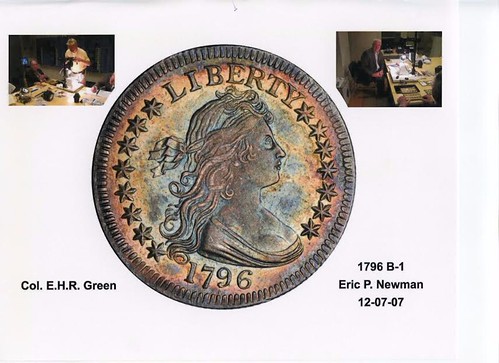
On our visit, we carefully took out each coin from the holder, photographed it, and put it back in the holder. This was done over two days. A highlight of the quarter collection is that many of the Newman-Col. Green quarters turned out to be from the “long lost” A.W. Browning Collection, and were plate coins in the Browning book on early quarters! Rory and I made this discovery the first night when back in the hotel, comparing digital photos taken that day on Rory’s camera with plates from a special edition of the Browning book. This pleased Eric to learn, but did not surprise him. There is a special edition of the Early Quarter Dollars of the United States Mint 1796-1838 (by Rory Rea, Brad Karoleff, Glenn Peterson, and John Kovach Jr.) with photographic plates taken by Rory on our visit. This special edition, leather bound book sold out quickly. Eric Newman was presented a complimentary copy of this special edition for his library.
Eric, thanks for the memories, Happy Birthday again, and thanks for the new Newman Numismatic Portal and its contents.
The Rittenhouse Society
The Rittenhouse Society writes:
Congratulations on your 106th Birthday from all your friends in the Rittenhouse Society. You’ve been aboard for 56 years now!
Thanks, everyone. For my part I will add my thanks to Eric for his heartfelt generosity over the years. One instance I'll never forget is when I asked Eric at an Early American Coppers convention in St. Louis if there was any chance I could see his numismatic library. Not only did he assent to my bold request, he gave me, John Burns and Charlie Davis a personal tour and took us for ice cream afterwards.
Eric has also been a longtime fan of The E-Sylum and I'm grateful today to be a part of the team helping to build the Newman Numismatic Portal, a magnificent gift to the numismatic community. Thanks, Eric, and Happy 106th!
Birthday greetings may also be sent to ericnumis@aol.com or
Eric P. Newman
P.O. Box 50376
St Louis, MO 63105
-Editor
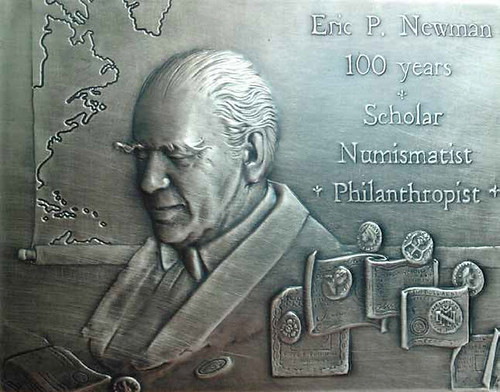
Medal for Eric P. Newman at 100

COINWEEK HITS YOUTUBE AND FACEBOOK MILESTONES
On Monday, May 15, 2017, CoinWeek surpassed two million views on its award-winning YouTube video channel.
CoinWeek’s award-winning videos have brought numismatics to a new generation of collectors, with popular series such as CoinWeek IQ, Cool Coins!, Cool Currency!, and the CoinWeek Podcast. Since CoinWeek’s launch in 2011, our video team has also covered many of the most significant hobby stories and events.
In February 2016, CoinWeek’s video Uncool Coins! went viral on social media, racking up nearly 200,000 views in just a few short days. The video featured coin dealer Julian Leidman and told the story of an unwise collector/ investor that cracked out a conditionally-rare $20 Liberty gold coin and cleaned it using an abrasive metal cleaner, destroying nearly all of the coin’s numismatic value. If undisturbed, the coin would have had a market value of about $250,000.
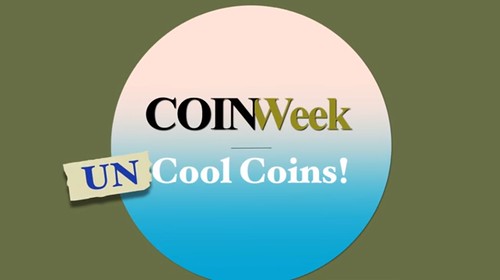
Another top performing video is CoinWeek’s in-depth look at the investment potential of the U.S. 1776-1976 quarter, titled On Collecting Bicentennial Quarters: Risk and Rewards. To date, that video has earned over 110,000 views, with hundreds of additional views each and every day.

The success of videos like these illustrate that numismatic topics, when discussed in an interesting and innovative fashion, can reach today’s collector
CoinWeek’s two million views was not the only major milestone reached this week. On our Facebook page, we have surpassed 40,000 subscribers, making CoinWeek the most popular numismatic news and information publisher on the popular social media site.
To read the complete article, see:
CoinWeek Reaches Two Major Milestones: Two Million Video Views & 40,000 Facebook Fans
(www.coinweek.com/video-news/coinweek-two-million-video-views-40000-facebook-fans/)
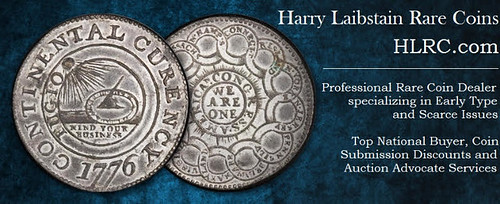
NOTES FROM E-SYLUM READERS: MAY 21, 2017
Hagar the Coin Collector

An Encounter With an 1802 Half Dime
Tom DeLorey writes:
The item about the 1802 Half Dime book reminded me of an unusual encounter I once had with an 1802.
James G. Johnson was the founding Editor of Coin World's Collectors Clearinghouse page in 1960. I had corresponded with the department for many years before joining it in 1974, and had visited it several times and knew both Johnson and his Assistant Editor, Ed Fleischmann.
Johnson was known in the hobby for having assembled a complete set of regular issue non-gold U.S. coins in circulated condition, including a well-worn 1894-S dime! He did not care about condition, partly because he had collected for many years on a teacher's salary before hearing loss had forced him to retire from that profession and offer his numismatic services to CW. He did not care how bad a coin was, so long as he had the date and mint mark represented.
Fast forward to an ANA convention in Denver, where I was working for Harlan Berk. A gentleman came up to the table with an 1802 half dime that was almost slick from wear, but which had become bent a bit in circulation in just the right way that the date was clearly preserved. After looking at it I told the gentleman that the coin was not for us, but that I had once worked with a gentleman whose collection it would have been perfect for.
After describing the collection I gave the collector's name, James G. Johnson. Startled, the man burst out "That was my father!" We laughed and shook hands and spent a while reminiscing about Jim!
More on Discours sur les medalles antiques
Regarding the 1627 numismatic book, picking up where he left off on this topic last week. Ron Haller-Williams writes:
 Seems that even when the "i" was used, the accent was optional for quite some time. Claude-François Menestrier, in his 1693 work "Histoire dv Roy Lovis le Grand Par les
Medailles, Emblêmes, Deuises, Jettons, Inscriptions, Armoiries & autres Monumens Publics. ...", has a large number of occurrences of medaille/s and of médaille/s, in about equal proportions:
Seems that even when the "i" was used, the accent was optional for quite some time. Claude-François Menestrier, in his 1693 work "Histoire dv Roy Lovis le Grand Par les
Medailles, Emblêmes, Deuises, Jettons, Inscriptions, Armoiries & autres Monumens Publics. ...", has a large number of occurrences of medaille/s and of médaille/s, in about equal proportions:
https://books.google.co.uk/books?id=jzE-a08pp3gC&printsec=frontcover
Whereas Antoine & Nicolas le Pois, in their* 1579 work "Discours sur les Medalles et Gravevres antiques, principalement Romaines: Plus, vne Exposition particuliere de quelques planches
ou tables estans sur la fin de ce liure, esquelles sont monstrees diuerses Medalles & graueures antiques, rare & exquises", uses “medalle” or “medalles” well over 100 times (not counting page
headings), and only once uses “medaille” (in the plural, on page 45, line 1 – a “typo”?); there are, however, 19 occurrences of medaillon/s.
https://books.google.co.uk/books?id=cVtPAQAAIAAJ&printsec=frontcover
* Really it was Antoine's work, but his brother Nicolas did the finishing touches and dedication after Antoine's death.
Nostradamus (1503-1566) has an instance of "medalles" (and no medaille/s or médaille/s), see (1611 edition)
https://books.google.co.uk/books?id=te4yAQAAMAAJ&dq=medalles&focus=searchwithinvolume&q=medalles
and
https://books.google.co.uk/books?id=GzvcTC3ck8YC&pg=PA546
it would be interesting to have the “take” of somebody whose first language is French and who is interested in old literature.
Hadrien Rambach writes:
Regarding the 1627 book, I have actually published three articles about it & its author:
Hadrien Rambach, « Louis Savot, la modernité d'un regard novateur », in C. E. Dekesel (éd.), Europäische numismatische Literatur im 17. Jahrhundert, Wolfenbütteler Arbeiten zur Barockforschung 42, Wolfenbüttel 2005, pp. 59-67 ;
Hadrien Rambach, « La Controverse Louis Savot – Charles Patin, numismates du XVIIème siècle », in Schweizer Münzblätter, vol. 231 (septembre 2008), pp. 71-75 ;
Hadrien Rambach, « Remarques sur Louis Savot et son Discours sur les medalles antiques », in Schweizer Münzblätter, vol. 245 (mars 2012), pp. 3-10
To read Hadrien's essays, see:
Hadrien J. Rambach (https://independent.academia.edu/HadrienRambach/Numismatics)
To read the earlier E-Sylum article, see:
NOTES FROM E-SYLUM READERS: MAY 14, 2017 : On Numismatic Spelling and Punctuation
(http://www.coinbooks.org/v20/esylum_v20n20a09.html)
On Eliminating Denominations
Last week Dick Johnson wrote:
I proposed to eliminate both the cent and the nickel, and later the quarter. These coins to be replaced by two new denominations for circulation, a $5 and a $10 coin, and later a $20 coin. This would leave the dime, half dollar, and dollar coin denominations intact.
Chip Howell writes:
This doesn't go far enough, in the "cents" zone. I'd get rid of the dime & half dollar, and leave the quarter to circulate--as someone calculated a few years ago, the dime has less buying power now than the half-cent did in the 1850s (my guess is, the only reason Congress was willing to tackle the issue back then, is that otherwise they'd've had to address slavery & the impending Civil War. Who knew government could be so hard?)
To read the earlier E-Sylum article, see:
DICK JOHNSON ON THE CURRENCY OPTIMIZATION ACT (www.coinbooks.org/v20/esylum_v20n20a20.html)
More on the Young America Furnace Company Notes

To read the earlier E-Sylum article, see:
WAYNE'S NUMISMATIC DIARY: MAY 14, 2017 : Young America Furnace Company Notes (www.coinbooks.org/v20/esylum_v20n20a17.html)
A Phylum of The E-Sylum
Dave Bowers writes:
Nice issue. It might be interesting sometime to issue a (printed) book with interesting tidbits from The E-Sylum — not definitive research, but “personality” stuff—the life, romance, and appeal of coin collecting and the collectors involved.
Joel Orosz writes:
I've got the title for the book: "A New Phylum of The E-Sylum."
Dave adds:
I took a survey and 98.67% of E-Sylum readers did not know what “phylum” meant.
London Dealer Richard Lobel
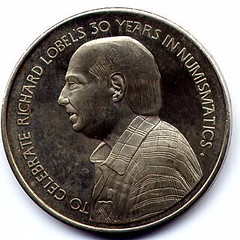

Dennis Tucker writes:
London coin dealer Richard Lobel was mentioned in last week’s issue. I have a medal that was issued I believe in the early 1980s to celebrate his 30th year in the business. It’s a neat addition to the category of numismatic personal medals
To read the earlier E-Sylum article, see:
NOTES FROM E-SYLUM READERS: MAY 14, 2017 : "We Forgive You" Bicentennial Medal
(http://www.coinbooks.org/v20/esylum_v20n20a09.html)
A Mystery Item Struck on Civil War Token
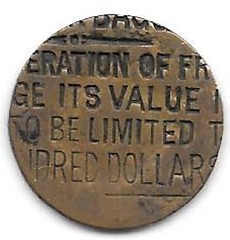
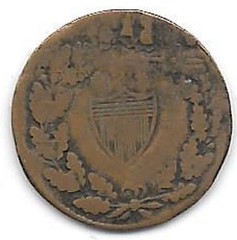
Bill Miller of Denton, MD writes:
I receive your delightful weekly E-Sylum report. I have a very enigmatic token that I would like to share with your readers with the hope that someone may be able to shed some light on its attribution.
A scan is attached. It is round, copper, and 18mm. The reverse is a listed Civil War die, 1352A, thought to have been done by a Baltimore, MD diesinker. The obverse suggests that it was originally meant for a larger planchett and only a partial legend is evident. Also, the reverse civil war die appears to have been over-struck at around 12 - 1 o'clock (it shows what appears to be a reverse "BA" and some sort of rosette).
A very mysterious item. Anything you can do to help solve the mystery would be appreciated.
Hall of Fame for Great Americans Medals
David Thomason Alexander writes:
Bravo to The E-Sylum for its continuing interest in the Hall of Fame for Great Americans medal series (HOF). As much as I love these impressive medals, however, I cannot agree with another writer's description of them as "one of the most popular in the world." The tragedy of this great medal series was that it never achieved the popularity needed for commercial success. Yes, there was the brief medal boom going on, but HOF cluttered up a still-limited market. Then too, offering a dizzying array of sizes and metals confused and intimidated many interested collectors.
On Getting 'Winstoned'
Chip Howell writes:
As for cutting one's nose on the new £5 note, Winston warned them: he promised blood and tears (besides toil & sweat).
To read the earlier E-Sylum article, see:
POLYMER BANKNOTES CUTTING DRUGGIE NOSES (www.coinbooks.org/v20/esylum_v20n20a22.html)
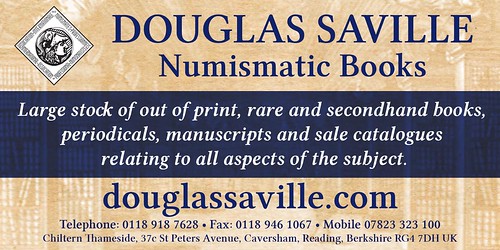
NOTRE DAME STUDY OF PRE-FEDERAL MONEY
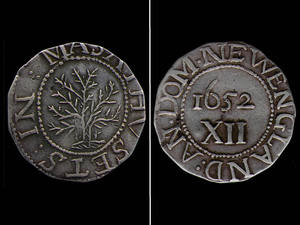 Legitimate and counterfeit currency played a significant role in the Revolutionary War – either as a justification to start it or as part of a strategy to win it. However, to understand the
economics of this time period, it is critical to know how colonial and counterfeit currency was produced, distributed, and utilized. To do this, new research at the University of Notre Dame will use
historical data, the dates of production, and the composition of coins or the inks on paper currency to map out approximate geographic origins of the money, including counterfeit bills.
Legitimate and counterfeit currency played a significant role in the Revolutionary War – either as a justification to start it or as part of a strategy to win it. However, to understand the
economics of this time period, it is critical to know how colonial and counterfeit currency was produced, distributed, and utilized. To do this, new research at the University of Notre Dame will use
historical data, the dates of production, and the composition of coins or the inks on paper currency to map out approximate geographic origins of the money, including counterfeit bills.
Notre Dame researchers, including both historians and scientists, will analyze more than 150 coins from colonial and early America, as well as approximately 550 pieces of paper currency currently held in the Hesburgh Libraries’ Rare Books and Special Collections. Some of these coins date back to the first mint in Boston (1652), which was the colonies’ first attempt to fight back against debased Spanish and Spanish-American silver currency, or coins that were lower in value than they were being traded for.
In explaining the research, Khachatur Manukyan, professor of physics and principal investigator on the project, said, “There is a theory that the first minted coins in the colonies actually used Spanish-American silver, just like Spanish-American coins. The thought is that the silver was melted down in Boston, a small amount of copper was added, and then the coins were distributed in Massachusetts. Since we don’t know how counterfeit and legitimate coins differ in composition, we can only uncover the truth about them by using instruments that analyze the elemental composition and impurities of these centuries-old coins.”
For example, historians know that Latin America was very rich in mineral resources, that mercury was used to recover silver from its ores in certain locations, and that the silver has lead and gold impurities. Therefore, by using non-invasive X-ray Fluorescent Spectroscopy and Particle Induced X-ray Emission method in Notre Dame’s Nuclear Science Laboratory (NSL), scientists can determine the impurities in coins and more easily identify where the silver, as well as the coins, originated.
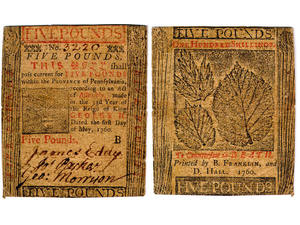 But colonial coinage isn’t the only currency of interest to researchers. Paper currency was first introduced to the Western World as England was searching for a way to restrict the amount
of silver in the colonies. However, after time, England also began imposing strict regulations on paper currency as it had with coins, which escalated tensions between England and the colonies.
But colonial coinage isn’t the only currency of interest to researchers. Paper currency was first introduced to the Western World as England was searching for a way to restrict the amount
of silver in the colonies. However, after time, England also began imposing strict regulations on paper currency as it had with coins, which escalated tensions between England and the colonies.
“The colonists wanted the freedom to produce coins and paper currency to facilitate exchange and stimulate economic growth,” said Louis Jordan, associate university librarian of academic services and collections. “However, the British government was still trying to maintain control so they heavily regulated production of all currency, which kept the colonies subservient to the needs of Britain. This added more fuel to the fire when it came to the colonies’ push for independence.”
This research will help develop a better historical understanding of not only where coins or paper monies were made, but also why certain elements – like unique printing or minting materials – were used. The project is funded through the Notre Dame Research Faculty Research Support Regular Grant program and the NSL.
To read the complete article, see:
NOTRE DAME RESEARCHERS ARE STUDYING SOCIAL AND ECONOMIC PATTERNS IN PRE-FEDERAL
AMERICA (https://research.nd.edu/news/uncovering-the-history-of-currency-and-counterfeiting-in-colonial-america/) 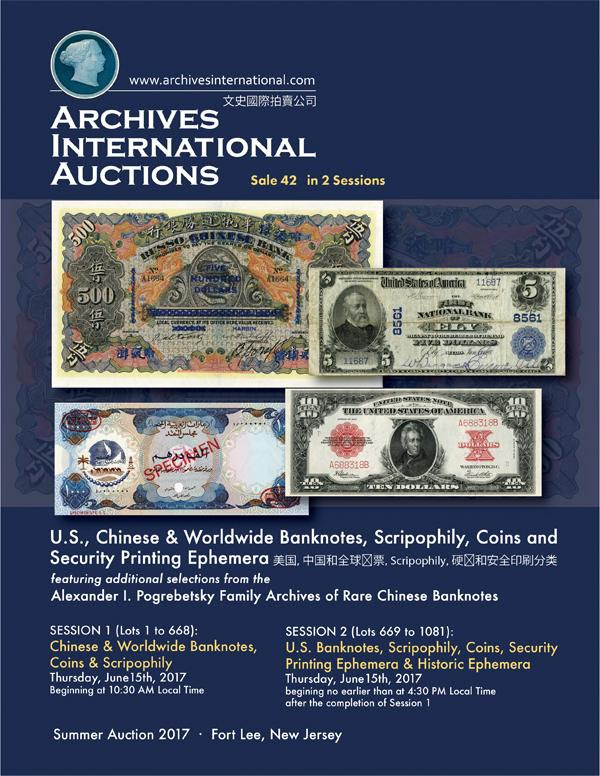
MERCANTI ACCEPTS DAVID RITTENHOUSE AWARD
Rich Jewell writes:
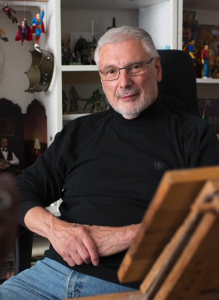 This past Wednesday night John Mercanti, 12th Chief Engraver (Retired) of the U.S. Mint, was honored by the Historic Rittenhouse Town of Philadelphia, PA. at the Merion Cricket Club. The
David Rittenhouse Award is given bi-annually to honor those who demonstrate excellence and represent one of the many contributions that Rittenhouse made to American History including that of an
astronomer, inventor, mathematician, surveyor and successor to Benjamin Franklin as President of the American Philosophical Society.
This past Wednesday night John Mercanti, 12th Chief Engraver (Retired) of the U.S. Mint, was honored by the Historic Rittenhouse Town of Philadelphia, PA. at the Merion Cricket Club. The
David Rittenhouse Award is given bi-annually to honor those who demonstrate excellence and represent one of the many contributions that Rittenhouse made to American History including that of an
astronomer, inventor, mathematician, surveyor and successor to Benjamin Franklin as President of the American Philosophical Society.
The award, a part of a year long celebration of the 225th anniversary of Rittenhouse being named the first Director of the U.S.Mint, was presented to John Mercanti for his decades of service and outstanding work as Chief Engraver/ Sculptor of the United States Mint.
John is the fourth recipient of the David Rittenhouse Award.

Jim Uram, Tom Uram, Andy Uram, Marianne and John Mercanti, Rebecca and Ron Harigal, Fran and Rich Jewell
To read the earlier E-Sylum article, see:
MERCANTI TO RECIEVE DAVID RITTENHOUSE AWARD (http://www.coinbooks.org/v20/esylum_v20n09a04.html)
THE BOOK BAZARRE
VOCABULARY TERM: REGISTER

For The Hartford Art School Medal sculptor Henri Kreis choose narrative relief of human figures on multiple base lines. The use of narrative relief is of ancient Egyptian origin most notable in the Roman Trajan’s Column of 113 AD. The Art School used Kreis’s design as the obverse for three different medals. Medal photo Medallic Art Company.
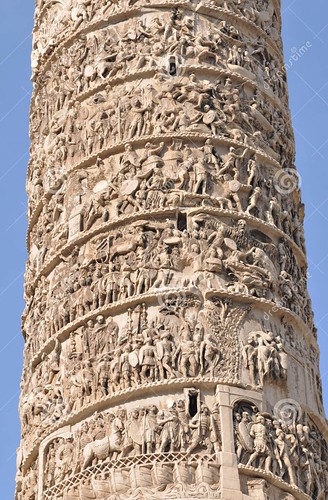 Register. The use of multiple ground lines and multiple figures and/or scenes of events in continuous strips. Register is a medallic form of narrative relief,
sometimes called continuous relief. A register in medallic form extends from one scene into another and occasionally crossing over a ground line or two. . The technique of narrative relief is quite
old, widely employed in both Egyptian and Roman art. The sequence of events and figures is usually in chronological order; as an art technique it presents a wealth of detail with a maximum of
clarity. Egyptian sunken relief is often in narrative form, however the most famous narrative relief in continuous form is the Trajan's Column with a 625 foot band (4-foot wide) winding up a
125-foot column.
Register. The use of multiple ground lines and multiple figures and/or scenes of events in continuous strips. Register is a medallic form of narrative relief,
sometimes called continuous relief. A register in medallic form extends from one scene into another and occasionally crossing over a ground line or two. . The technique of narrative relief is quite
old, widely employed in both Egyptian and Roman art. The sequence of events and figures is usually in chronological order; as an art technique it presents a wealth of detail with a maximum of
clarity. Egyptian sunken relief is often in narrative form, however the most famous narrative relief in continuous form is the Trajan's Column with a 625 foot band (4-foot wide) winding up a
125-foot column.
CLASS 03.2
Looking for the meaning of a numismatic word, or the description of a term? Try the Newman Numismatic Portal's Numismatic Dictionary at: https://nnp.wustl.edu/library/dictionary

JOHN EDGAR BURTON (1847-1930)
I have been doing some research on 19th and early 20th century collector John Edgar Burton. If he was living today I am sure he would be am enthusiastic E-Sylum reader, as he collected both coins and books.
His coins were sold in auctions by dealers Haseltine, Woodward, Massamore, Anderson Galleries, and Mehl (two sales). The Woodward sale is given an A rating by Adams. I own all these catalogs except the sale by Massamore. His books were sold in eight sales by Bangs, Anderson Galleries, and American Art. I do not own any of these book sales, so I am not sure how much was numismatic.
In 1929 Burton wrote a rather lengthy biographical article to the ANA in which he claimed to be the oldest living coin collector. It was published in the the October 1929 Numismatist issue. For any readers who have access to this issue, the letter is interesting. He started collecting coins in 1854. He said,
"I was fortunate in that Jimmie Dolbie a saloonkeeper where my grandfather, a soldier of the war of 1812 took his nip daily, and Dolbie told me I could come in each day after school and look over all the cents and half cents in the till and take out what I wanted and put another in its place."
He later got the addresses of all the early dealers including Grandpa Coogan (sic), He later visited early dealers in New York city and Philadelphia. He said that at age 82 he is as interested in coins as when he was a boy.
John Edgar Burton (1847-1930), was born son of John Edgar Burton, Sr. (1825-1874), a boot and shoe maker, and Ruth Jeanette Allen (1826-1895).
He was born in New Hartford, Oneida County, New York on October 19, 1847.
He began collecting Large & Half Cents in 1854. He was one of the four youngsters in New Hartford, New York, who were coin collectors by that date. The other three were Charlie Millard, Stevie Childs, and Byron Case. Burton tells us in his autobiographical letter to the A.N. A. between July and August, 1929, and Moritz Wormser suggested it be read at the Third Session, Tuesday, August 27, 1929, at the A, N. A. Convention, and recorded in the minutes :
"I was fortunate in that Jimmie Dobie, a saloonkeeper, where my grandfather, Asa Allen, a soldier of the War of 1812, took his "nip" daily, and Dobie told me I could come in each day after school and look over all the cents and half cents in the till and take out any I wanted and put another in its place. I secured in a few years a considerable collection of these. By 1857 I had the best in town. Soon I learned the address of John W. Haseltine, John W. Scott, Elliot Woodward, W. H. Sampson and Grandpa Coogan. Later I visited all five of these dealers and began to realize that the old coin business was a big affair.
On this trip I met Mr. S. H. Chapman, who was then a clerk and associate in the office of John W. Haseltine, in Philadelphia. On my next trip I met Mr. Bangs, of Bangs & Co. , 789 Broadway, N. Y. I was a principal in the public schools of Illinois at this time and had a limited bank account, but got so well acquainted that I found there was such a thing as credit.
Having secured a better position in the schools at Lake Geneva, Wis. , I bought from these dealers a large lot, including 1809, 1811, 1814 and a new little white cent of 1856, said to be the rarest thing out. I have since made thirty-nine trips to New York and learned much of the world and of the numismatic line of dealings.
I have enjoyed several old-time wine dinners with John W. Scott and others in the business world, but so far as I now know all these old-line dealers have passed on into the land not marked on maps, except only the Chapman brothers, who are still living and with whom I still deal and purchase choice varieties. I am always proud of my old-time friends and can truthfully say that I have never yet met a dishonest man in the old-coin business. It is a cheerful and pleasant pastime, an intelligent and historically valuable field, and its value to the young is all for good and no hidden foe lurks behind an old coin.
I am 82 and take as great pleasure and interest in a fine coin as I did when a boy. It is an honorable and a most commendable work and steadily growing, as it deserves, and has in its followers many of the best men now living. Its twin occupation, the stamp collecting branch, is ever growing and the work covers Europe, Asia, South America and Africa and Australia. If any one word represents the character of the men in these twin pleasures, it is the word sincerity. Yours for coins and stamps."
During the Lincoln campaign for presidency in 1859 he traveled by train to Utica, New York, where the twelve-year-old John Edgar Burton first saw him after climbing a telephone pole to catch a glimpse. That encounter developed into a lifetime devotion and passion for Lincoln and collecting Lincolniana.
In 1868, he graduated Cazenovia Seminary. He began his career as a school teacher in New York.
On December 7, 1869, Burton married Lucretia “Dell” Delphine Johnson (1850-1938).
In 1869, he moved to Richmond, Illinois taking a teaching position there.
In 1870, he moved to Lake Geneva, Walworth County, Wisconsin, as the new superintendent of schools.
He came to Lake Geneva in 1870, and after teaching school, in 1874, purchased and ran the newspaper Geneva Herald. In 1879, he began investing in various businesses and industry. Working from his office in Milwaukee, Burton invested heavily in mining.
In August 1880, he sold part of his coins as the John E. Burton collection catalogued by John W. Hazeltine, Sale 47, August 9-10, 1880 (See John Weston Adams, Vol. 1, 51).
His coin cabinet was purchased by Woodward in the Fall of 1881. His collection included a large amount of 1794 large cents, including the discovery S-33, and was sold October 26-28, 1881 by W. Elliot Woodward. One of the two catalog plates depicts large cents. According to Frossard he swindled both John W. Haseltine and W. E. Woodward in several coin transactions.
In 1885, he became manager of Equitable Life Insurance of New York for the entire state of Wisconsin. That same year he started iron and copper mining operations in the Gogebic Range in northern Wisconsin and Michigan. He was also involved in gold and crystal mining in California, silver mining in Colorado and Mexico, and tin mining in Alaska. Burton's businesses made him a millionaire.
In 1887, the copper mines in the Gogebic Range fail. In 1889, panic struck investors in his mining operations and they bail out. Afterwards he went to Mexico to begin silver mining there.
His main hobby besides coin collecting was collecting Abraham Lincoln books, manuscripts, and memorabilia, in which he amassed a huge collection.
In the late 1890s Burton's mining businesses failed. He was also a financial investor with Levi Odell and his invention of the Odell Type-Writer, owning 4/5 interest in the Odell Type Writer Company. He eventually lost his fortune and was forced to sell his collection of 3,000 objects of Lincolniana. Burton also collected books and paintings as well as coins.
He applied to the ANA in January 1915. See The Numismatist, Vol. XXVIII, No. 1, January (1915) : 21
His remaining coin collection was finally sold as well as his Lincolniana (Parts 1 & 2) in November 1915 by Anderson Galleries, New York.
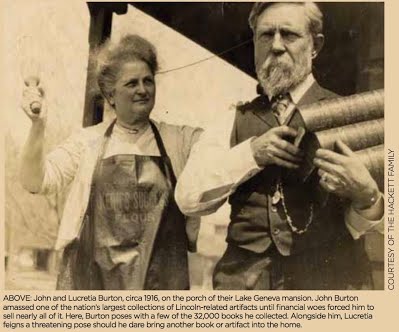
Photo published in a magnificent gem of an article by Lisa M. Schmelz, "Losing Lincoln," At The Lake Magazine, Autumn (2011) : 36-44;
The final two sales of his coins were sold by B Max Mehl sale 48, April 30, 1918 and sale 65, April 17,1923.
In January 1926, he had reapplied for membership with the A.N.A. with a new membership number.
He died in 1930 and was buried in Lake Geneva, Wisconsin.
Acknowledgements:
Thanks to Dave Hirt for informing me of Burton's 1926 A.N.A. reapplication and new ANA Member No. Also, the two B. Max Mehl coin sales. Thanks Dave.
To read the complete article, see:
BURTON, Jr., JOHN EDGAR (https://sites.google.com/a/numismaticmall.com/www/
numismaticmall-com/burton-john-edgar)

ARTICLE EXAMINES ANCIENT COIN DEALER FREEMAN
 The Ancient Coin Club of Los Angeles meets on the second Sunday of every month in the so-called “community room” of the Sherman Oaks Galleria. It’s an antiseptic, heavily air-conditioned
conference room with an entrance near the Cheesecake Factory. A typical meeting consists of each attendee — mostly older men — telling the others about their recent purchases. They pass to one
another the newly bought coins, for example, a denarius, a silver Roman coin about the size of a dime with the thickness of a poker chip.
The Ancient Coin Club of Los Angeles meets on the second Sunday of every month in the so-called “community room” of the Sherman Oaks Galleria. It’s an antiseptic, heavily air-conditioned
conference room with an entrance near the Cheesecake Factory. A typical meeting consists of each attendee — mostly older men — telling the others about their recent purchases. They pass to one
another the newly bought coins, for example, a denarius, a silver Roman coin about the size of a dime with the thickness of a poker chip.
At a recent meeting, members passed around an ancient, Roman Empire bronze sestertius, about the size of a silver dollar, with a portrait of the emperor Marcus Aurelius.
“That’s a beautiful patina,” one member said, referring to the coin’s surface area, which he held about 2 inches from his eye.
The second half of the meeting is devoted to a “seminar” on Sulla, a Roman general who invaded his home country and had the Senate declare him dictator in 82 B.C. (or possibly 81 B.C., history of that era is a bit fuzzy), briefly interrupting the Roman Republic. The members of the club slog through Sulla’s biography, from his early childhood and his wars with Gaius Marius to his bloody reign, when he sought to undo the populist land reforms of his predecessors. Especially noteworthy to this group is that Sulla is believed to be the first living Roman to put his face on a coin, a silver tetradrachm struck around 85 B.C. Another coin depicts a dream Sulla once had, in which he envisioned a goddess placing a thunderbold into his hands to strike down his enemies.
“That coin is extremely rare,” says David Michaels, the director of classical coins at Heritage Auction Galleries, who attends the Ancient Coin Club’s meetings whenever he’s in town. “There are fewer than five in the world. If one came on the market today, it would probably sell for a quarter million dollars.”
Nearly everyone at the coin club’s meeting has heard of Rob Freeman, a noted coin scholar, or numismatist, and the owner of Freeman and Sear, formerly one of the top five ancient-coin dealers in the country. About half the people in the room knew Freeman personally. Michaels was the sales director of Freeman and Sear for nine years. Another man in the room was, for a time, Freeman’s lawyer, and many of the others were loyal customers.
“He was the finest dealer I’ve ever worked with,” says Barry Rightman, who’s been collecting coins for half a century and has known quite a few dealers. “I have a number of coins in my collection that I bought from him, or he got for me in European auctions. I had exceptional trust in him.”
Most of Freeman’s peers and customers felt this way, which is why they were so surprised when rumors about him began to circulate, citing missing coins, bounced checks, cheated customers, some sort of Ponzi scheme. Then there’s the mystery of what happened to the head of the Roman Lucius Aelius Verus, a larger-than-life bronze head depicting the adopted son of Emperor Hadrian and the father of Co-Emperor Lucius Verus.
“There are so many rumors going around, it’s hard to separate fact from fiction,” says Victor England Jr., co-owner of Classical Numismatic Group, one of the nation’s top coin dealerships.
At least 20 lawsuits have been filed against Freeman in the last four years, alleging such acts as breach of contract, breach of fiduciary duty, misrepresentation, negligence and fraud. One such complaint, filed in January 2016 by Marie Rosales and Jack Luu, alleges the two plaintiffs were victims of a “Ponzi scheme,” and were “swindled out of more than $1 million by con men passing themselves off as legitimate dealers of ancient coins and antiques.”
“I’ve known Rob for probably 25 years,” says Ira Goldberg, who with his cousin Larry owns an auction house. “I would say he just went bad. He was a fine numismatist, always honorable and hardworking. That all changed about three years ago.”
Reached by phone, Freeman was reluctant to talk. His lawyer had advised him not to. He said he couldn’t discuss anything mentioned in any of the many lawsuits filed against him. But he was eager to salvage what he could of his tattered reputation.
“I’ve been in this business for 35 years,” Freeman said. “I’ve been very upstanding in this business. I’m a great numismatist. I didn’t suddenly become a treacherous villain.”
David Schwager writes:
I have to compliment the reporter on making almost no numismatic mistakes.
To read the complete article, see:
The Downfall of an Ancient Coin Dealer Who Defrauded Customers of
Millions and Lost a Bronze Head (http://www.laweekly.com/news/rob-freeman-was-one-of-the-countrys-biggest-ancient-coin-dealers-then-he-broke-bad-8234006)
STUDY EXAMINES RARE COIN INVESTMENT RETURNS
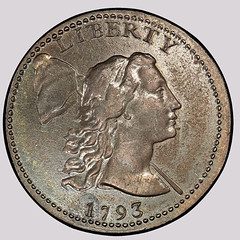 BEHIND the heavily fortified door of Stack’s Bowers, a gallery of rare coins in New York, smiling salesmen show off their precious wares neatly displayed in pristine glass cabinets. To the
untutored eye, it looks like pocket change. Numismatists, who study the history and art of old money, see well-preserved coins as aesthetic masterpieces worth many times their face value. At an
auction organised by Stack’s Bowers on March 31st, an American cent from 1793 (pictured) sold for $940,000, becoming the costliest penny ever. An index of tangible alternative asset classes compiled
by Knight Frank, a consultancy, shows that returns on rare coins over ten years to the end of 2016 were 195%, easily beating art (139%), stamps (133%), furniture (-31%) and the S&P 500 index (58%).
Coins are more portable than paintings or furniture, and boast a higher value-to-volume ratio. Stamps may be lighter, but, come doomsday, cannot be melted down.
BEHIND the heavily fortified door of Stack’s Bowers, a gallery of rare coins in New York, smiling salesmen show off their precious wares neatly displayed in pristine glass cabinets. To the
untutored eye, it looks like pocket change. Numismatists, who study the history and art of old money, see well-preserved coins as aesthetic masterpieces worth many times their face value. At an
auction organised by Stack’s Bowers on March 31st, an American cent from 1793 (pictured) sold for $940,000, becoming the costliest penny ever. An index of tangible alternative asset classes compiled
by Knight Frank, a consultancy, shows that returns on rare coins over ten years to the end of 2016 were 195%, easily beating art (139%), stamps (133%), furniture (-31%) and the S&P 500 index (58%).
Coins are more portable than paintings or furniture, and boast a higher value-to-volume ratio. Stamps may be lighter, but, come doomsday, cannot be melted down.
The rare-coin market, however, has long had a reputational problem. What distinguishes a highly valuable coin—lustre, sharpness of detail, toning and friction-wear—is imperceptible to the untrained eye. So shady coin-dealers for decades successfully duped investors into paying top dollar for non-premium or even counterfeit coins.
The market’s wild-west days ended in 1986 when the first independent coin certifier, the Professional Coin Grading Service (PCGS), based in California, established itself as an authority on authenticity and quality. Grading each coin on a one to 70 scale, PCGS gave the market transparency, boosting investor confidence and sales volumes. Today, global sales of rare coins are estimated at $5bn-8bn a year, with 85% of the market in America. So important has third-party grading become that almost all rare coins sold at auction these days have been graded and sealed in stickered plastic by either PCGS or its main rival, Numismatic Guaranty Corporation (NGC), which is based in Florida.
Some blame the grading system itself for the eye-watering returns. Investors cling to the assigned grade: even a one-point boost can double or even triple a coin’s retail price. An 1884 silver dollar from the San Francisco mint, for instance, sells for $19,500 at the 62 grade but surges to $65,000 at 63.
The grading process is subjective: the evaluation criteria include “eye appeal”. Scott Travers, a coin dealer in New York, says investors sometimes resubmit the same coin ten or 20 times to the same company in hope of an upgrade. All this led to a steady “grade inflation”, that has been cheered along by investors. But in the long term, a sustained rise by simple fiat in the number of high-grade coins will surely depress prices. Already, a new type of “grader of graders” has emerged, hoping to instil some discipline by rating the consistency of the two primary graders. Next: graders of graders of graders?
To read the complete article, see:
Numismatics—acquiring old coins—outperforms other
investments (http://www.economist.com/news/finance-and-economics/21722234-once-shady-market-aspires-respectability-numismaticsacquiring-old)
THE BOOK BAZARRE
COINTELEVISION INTERVIEWS FOLEY, THREE YNS
78th Central States Coin Convention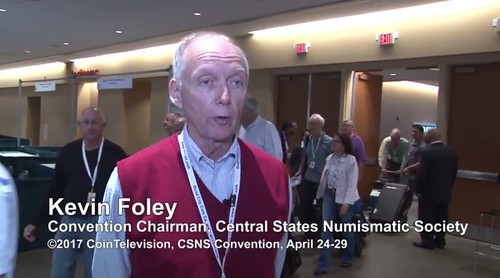
To view the complete video, see:
CoinTelevision: 78th Central States Coin Convention Continues Successful Tradition. VIDEO: 2:37
(https://www.youtube.com/watch?v=9aKmOyvralU)
Young Turks of Numismatics
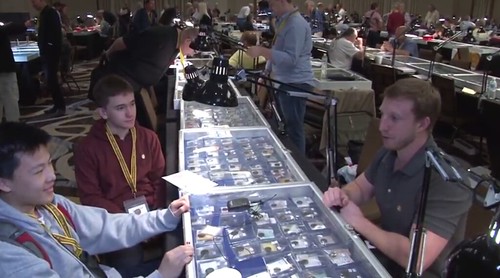
To view the complete video, see:
CoinTelevision: Young Turks of Numismatics. VIDEO: 5:09. (https://www.youtube.com/watch?v=zVKXN7v-g-8)
COIN DEALER MAURICE A. STORCK
Alan writes:
The longest living professional coin dealer is Maurice A. Storck who retired in 1970 from the coin & stamp business, now lives in Tucson AZ, is alert and well and approaching 100 years, and still mans a bourse booth at the Tucson Veteran's regular stamp and coin meeting. He physically attended the 1954 Sotheby's King Farouk Cairo Egypt auction, successfully bidding and reportedly still owns some of the Farouk bulk lots intact - including one auction lot of large cents, 1793 up.
Maurice is one of the few remaining veterans who survived the Pearl Harbor Japanese sneak attack and went on to fight in Guadalcanal, the Solomon Islands and the Philippines until he was wounded.
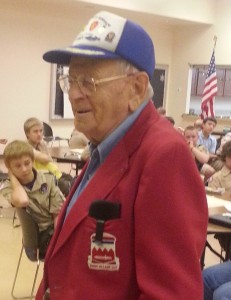 ME: Welcome Maurice, and thank you for your service to our country. Maurice, what are you up to these days?
ME: Welcome Maurice, and thank you for your service to our country. Maurice, what are you up to these days?
Well, I work 40 to 60 hours a week volunteering at the VA for the past 6 years plus. I handle the stamp and coin program for the whole USA, sending out stamps, coins, Sports Cards to shut-in and disabled veterans for rehabilitation. I’ve got over 47,000 hours volunteer work there. It might be the most volunteer hours anybody’s got in the United States.[laughter]. [Note: Maurice heads up the Veterans National Stamp and Coin Club at the VA in Tucson]
ME: When did you start doing that and why?
Well, I’ve been in the stamp and coin business all my life, and I retired April 1st 1970, and I travelled in a motorhome with my wife for ten years around the country; then after that, well I had to have something to do so I contacted the VA. I’ve recovered 100% medically, so it was natural for me to do it, actually.
ME: So, how did you end up at Pearl Harbor, of all places?
I used to be in the old Hawaiian Division, in fact I’m perhaps the only living member of the old Hawaiian Division; and I was in the Hawaiian Division for over a year before Pearl Harbor.
ME: Did you have any warning about the attack?
Oh, shit no! The night before I was selling show stubs at the movie theater in Scofield. We had no warning whatsoever. In fact, of my company, there was only about 6 of 198 that was in the barracks. All the others was all around the island, some were married and at home and so forth.
ME: Is there anything you would like to have people do, or anything people could do to help you at the VA in some way?
We’d have to get somebody that knows something about stamps and sports and so forth. Otherwise, I’d be wasting my time – I put in more hours than anybody that works for me.
After the war, as I said, I was in the rackets, I was dealing in coins and stamps when I was in school. All through the war I was always dealing in stamps whether I was in New Caledonia or Guadalcanal; Japanese invasion money and stuff, and I done it all my life.
In fact, I’m the only living dealer in the whole world that attended King Farouk’s auction in 1954. I bought the bulk of his coin collection. When they kicked him out of Egypt in 1953, they had a big auction in 1954, and I was one of the nine American dealers that was invited to attend the auction.
There were other dealers from all over the world – and I knew them all, cause I used to go to Europe every six months, and, they’re all dead. I’m the last living member. I still got most of the coins that I bought.
To read the complete article, see:
MAURICE A. STORCK ENDURED AND SURVIVED THE JAPANESE ATTACK ON PEARL HARBOR, DECEMBER 7TH, 1941.
(http://www.rightvoicemedia.com/2014/05/corporal-storck-remembers-pearl-harbor/)

TWO 1960S CELEBRITY AUTOGRAPHED NOTES
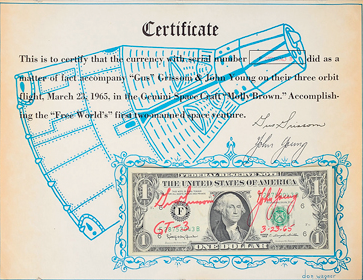
The first is a Very Fine condition Atlanta District Series 1963 $1 Federal Reserve note that had a closing bid of $7,417 (plus 22.5 percent buyer’s fee) on an estimate of only $500+. It is a piece of American history in that it accompanied astronauts Virgil “Gus” Grissom and John Young on their three-orbit Gemini program flight of March 23, 1965, in the spacecraft Molly Brown. The bill is signed in red felt tip pen with “Gus Grissom, GT-3” and “John Young, 3-23-65.” The accompanying certificate is signed in black ballpoint by Young and has a preprinted signature of Grissom.
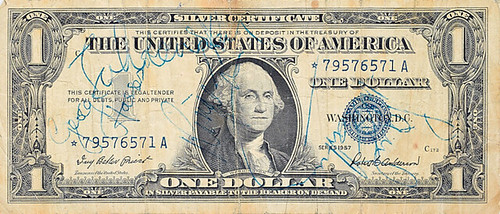
The other lot, a Series 1957 $1 silver certificate star note estimated at $7,000, was called “One buck signed by the Beatles.” It is signed in blue ballpoint by George Harrison, John Lennon, Paul McCartney, and Ringo Starr. It is described as in Very Good condition, with scattered light toning and overall creasing. The consignor says that these signatures date to 1964 to 1965.
The lot closed at $5,069 plus the buyer’s fee, for a total of $6,209.52.
To read the complete article, see:
Common but pricey: autographed notes draw strong bids in auction
(www.coinworld.com/news/paper-money/2017/05/common-but-pricey-autographed-notes-draw-strong-bids.html)
NUMISMATIC NUGGETS: MAY 21, 2017
Ebling's Columbia Garden Counterstamp
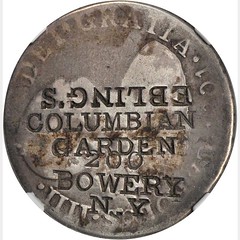
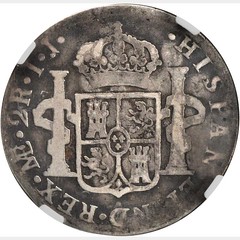
New York--New York. EBLING'S / COLUMBIAN / GARDEN / 200 / BOWERY / N.Y on an 1801 2 reales. Brunk E-59, Miller NY-165A. VG-8 (NGC).
The Bowery in lower Manhattan was the center for culture -- high as in theaters, low as in gambling dens and ladies of the night. Somewhere in between was the vast Atlantic Garden beer hall at 150 Bowery, memorialized on Civil War tokens and famous for two huge orchestrions or automatic orchestras -- the first installed in the 1860s and its successor brought after being a sensation at the World's Columbian Exposition in 1893. We have not delved deeply into Ebling's, but it is likely that an hour or two spent in Internet research would furnish enough for a nice feature story in the Token and Medal Society Journal.
As to the silver 2 reales coin, this and its cousins were legal tender in the United States and were more common in the 1850s in circulation than were Liberty Seated quarters of comparable exchange value.
This example of Ebling's counterstamp has the first line of the stamp inverted. A nice bold punch shows all letters deep. Brunk does not mention any known pieces with the name inverted making this one probably unique. The host coin shows a nicely profiled bust with most legends easily read.
Provenance: Ex Aaron Feldman, May 3, 1958; our (Stack's Bowers) sale of the John J. Ford, Jr. Collection, Part XXIII, August 2013, lot 21711. Lot tag and paper envelopes with attribution and pedigree notation included.
To read the complete lot description, see:
New York--New York. EBLING'S / COLUMBIAN / GARDEN / 200 / BOWERY / N.Y on an 1801 2 reales. Brunk E-59, Miller NY-165A.
(https://auctions.stacksbowers.com/lots/view/3-7KY9T)
Risley & McCollum's Hippodrome Token
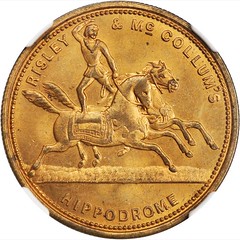

New York--New York. (Circa 1850s) Risley & McCollum's Hippodrome. Miller-NY 663 (type). Gilt brass. 33 mm. MS-63 (NGC).
TROISIEME reverse. 80% or more of the original gilding survives, with wisps of olive-green on the high points and a dusting of blue on the reverse. A classic early American circus token, described as "extremely rare" by Satterlee in 1862.
Provenance: Ex F.C.C. Boyd; our (Stack's Bowers) sale of the John J. Ford, Jr. Collection, Part XXIII, lot 22516. Lot tag and paper envelope with attribution notation included.
1853-56: FRANCONI'S HIPPODROME
NW corner of Fifth Avenue and 23rd Street
- May 2, 1853: Opening of Franconi's Hippodrome, a large (4,000-seat) wood-and-brick structure with a canvas roof, modeled after the Hippodrome de l'Etoile of Laurent and Victor Franconi in
Paris, and erected on the site of Thompson Madison Cottage. The company is that of Sands' Circus, with a small addition of "French" equestrians imported from Batty's Hippodrome
(formerly Astley's Amphitheatre) in London and led by Henri Franconi (actually Henri Narcisse Franconi, a son of the celebrated Henri Franconi, Laurent's brother—thus engendering an intended
confusion). The arena was active with more or less successes until 1856, when it is demolished to make way for the Fifth Avenue Hotel.
To read the complete article, see:
1853-56: FRANCONI'S HIPPODROME
(http://www.circopedia.org/Circus_buildings_in_New_York_City#1853-56:_FRANCONI.27S_HIPPODROME)
To read the complete lot description, see:
New York--New York. (Circa 1850s) Risley & McCollum's Hippodrome. Miller-NY 663 (type). Gilt brass. 33 mm.
(https://auctions.stacksbowers.com/lots/view/3-7KYG3)
1861 Beauregard Confederate "Dime"
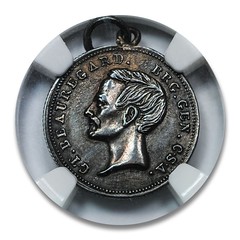
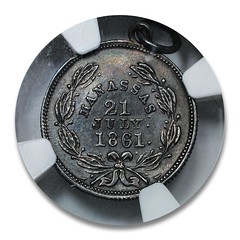
Original mount and loop, as issued. A prized and extremely elusive Civil War rarity. Acquired from the 1982 New York Public Library auction by Bowers and Ruddy, this piece comes from the cabinet of Dr. Thomas A. Emmet. Emmet published the first mention of this medal in numismatic literature, based upon this precise specimen, in the American Journal of Numismatics for February 1868, which noted this medal was "one of a number presented by the city of New Orleans immediately after the first battle of Bull Run." The article mentioned that this specimen "was sold by a Confederate soldier in New York." The Emmet article, and this piece, were also mentioned in Bauman Belden's War Medals of the Confederacy, published in 1915.
Beyond its historical importance as the first published specimen of this medal, this example is also among the very finest. The ANS piece is well worn and has a large misshapen hole blown through it (the usual remedy for the mount falling off), in addition to two smaller holes that were likely intended to fasten it to a piece of clothing or jewelry.
Peter Bertram recorded only 4 examples ... There are a few more than that, but certainly fewer than 10 are known. An NGC EF-45 example brought nearly $12,000 in a 2014 sale. Virgil Brand paid $25 for his in 1905, and Lyman Low got $21 for a specimen called "Fine" in 1921.
I remain firm in my belief that this medalet was struck in the American South, as its texture does not resemble any French medal of this era, nor are the CR engraver's initials known on any French medal of this era. The reeding has long suggested an intended similarity to a U.S. dime, though it's doubtful any actual currency use was intended.
A classic rarity of the Civil War, these pieces turn up on the market with remarkable infrequency.
To read the complete item description, see:
Extremely Rare 1861 P. G.T. Beauregard Confederate
"dime", the Dr. Thomas A. Emmet discovery specimen
(http://www.jkamericana.com/featured2/extremely-rare-1861-g-t-beauregard-dime-the-dr-thomas-a-emmet-discovery-specimen#.WR73G2aGPv8)

DOGS ON ANCIENT COINS
DOGS AND PEOPLE HAVE BEEN COMPANIONS for at least 15 thousand years. Some DNA evidence suggests that this date might be pushed back as much as 40 thousand years ago. Dogs and wolves are closely related, and in the earliest images created by Stone Age artists, it is not always clear whether we are seeing a dog or a wolf. In ancient Egyptian art, we occasionally see working dogs used in hunting and war. Images of the dog, both realistic and fanciful, begin to appear on coins soon after dawn of coinage in the sixth century BCE.
Possibly the earliest appearance of any canine on a coin is the winged dog on a stater of Cyzicus dated to c. 550 – 450 BCE[3]. Flying dogs seem to have gone extinct in antiquity, much to the relief of the birds.
Another fanciful image on a Cyzicene stater (c. 500-450 BCE) is Cerberus (or Kerberos) the mythical three-headed hound that guarded the entrance to the underworld. On the coin, only two heads are visible. A perfectly ordinary dog (although beautifully rendered) appears along with the emblematic tuna on another stater of roughly the same date.

 One of the last examples of a dog on a Roman imperial coin is a rare gold aureus of Emperor Probus dated to 278 CE. The spectacular reverse shows the final labor of Hercules, who was
required to enter the underworld to capture and bring back the three-headed dog Cerberus. This is one of the few coin images of Cerberus to clearly show all three heads, ferociously snapping at the
hero.
One of the last examples of a dog on a Roman imperial coin is a rare gold aureus of Emperor Probus dated to 278 CE. The spectacular reverse shows the final labor of Hercules, who was
required to enter the underworld to capture and bring back the three-headed dog Cerberus. This is one of the few coin images of Cerberus to clearly show all three heads, ferociously snapping at the
hero.
To read the complete article, see:
Dogs on Ancient Coins (www.coinweek.com/ancient-coins/dogs-on-ancient-coins/)
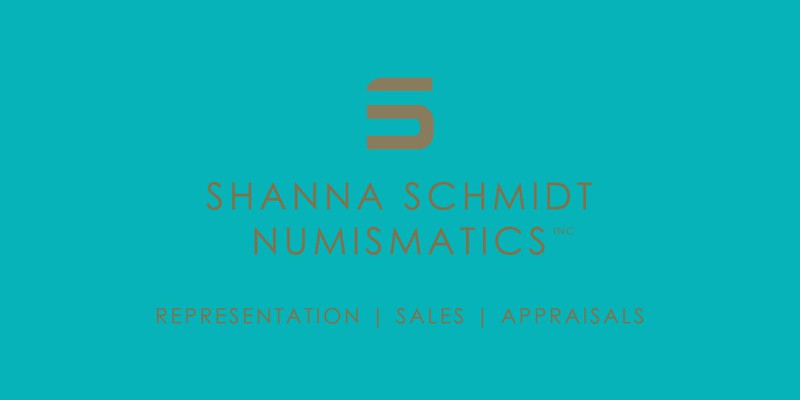
THE HOUSE OF WINDSOR CENTENNIAL CROWN

On January 1, the Royal Mint unveiled a new Crown coin that marks the centennial anniversary of the introduction of the British Royal family’s dynastic name—that of Windsor, which was introduced in 1917. The circumstances of why the British Royal family changed its dynastic name were wholly due at the time to the consequences of what was referred to as the Great War, which began in 1914 (see below). The name of Windsor continues today, and it has been decreed by royal ascent by the current British head of State, HM Queen Elizabeth II, that the name of the dynasty should survive into the next succeeding generations and heirs to the British throne.
The coin is designed by Timothy Noad and includes a fitting representation of the dynasty’s name: a depiction of Windsor Castle’s Round Tower flying the royal standard, surrounded by a wreath of acorn and leaf clusters, symbolizing English oak trees. St. Edward’s crown is placed just above the royal standard. CENTENARY OF THE HOUSE OF WINDSOR surrounds the primary design, and the coin’s year of issue, 2017, is placed below.
The obverse includes the fifth effigy of HM Queen Elizabeth II, designed by Jody Clark and in use since 2015, along with the denomination, 5 POUNDS.
The precious-metal versions include the edge lettering THE CHRISTENING OF A DYNASTY. The Brilliant Uncirculated coin is encased in a colorful presentation blister-pack folder. The silver Proof editions, issued in both traditional crown and piedfort strikes, are each housed in a custom presentation case with certificate of authenticity.

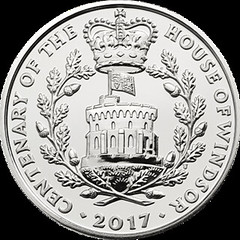
The Creation of a Truly British Royal Dynasty
The creation of the royal family’s dynasty 100 years ago is unusual in the sense that it was done as a measure to show the people of Great Britain that their royal family was truly British in every way, with the exception of their roots and dynastic heritage. Although the history of the royal family teaches us that their claim to the English (later the British) throne spans back a millennium, technically speaking, the current royal family observed their dynastic tercentenary in 2014 with the anniversary of the arrival of the Elector and Prince George of Hanover to the United Kingdom.
The German prince was recognized as the new king of Great Britain after the death of the country’s last Stuart monarch, Queen Anne, in 1714. The Hanover dynasty reigned in the United Kingdom until the death of Queen Victoria in 1901, as she was the last Hanoverian born in the male line to succeed to the British throne. It had been understood that a new dynasty would eventually be introduced onto the British throne as a consequence of the 1840 marriage of Queen Victoria to Prince Albert of Saxe Coburg and Gotha. Upon the accession of their son, King Edward VII, Hanoverian rule ended, and the new dynasty, that of Saxe Coburg and Gotha, was recognized.
As a result of the United Kingdom’s declaration of war on the German Empire in 1914, a wave of anti-German sentiment swept through the British Isles. At the height of the war, it came to the attention of King George V that a newspaper had described him as “uninspiring and alien,” to which he reportedly replied, “I may be uninspiring—but I’ll be damned if I’m an alien!”
There arose the question of what name should be adopted by the royal family. There was no English version of their dynastic name, and the actual surname of Saxe Coburg and Gotha was disputed as being either “Wettin” or “Guelph” (both very Germanic in their origins). It was suggested by the government that they adopt the name of the seat and traditional place of residence of the royal family: Windsor. The change was seen as perfect. The name’s association with the thousand-year-old castle and its place in British history would reflect both the tradition of the monarchy as an institution and the continuity necessary to assert the right of the current royal family to claim the British crown.
To read the complete article, see:
United Kingdom: Centennial of royal dynasty celebrated on new crown coin
(http://world.mintnewsblog.com/2017/05/united-kingdom-centennial-of-royal-dynasty-celebrated-on-new-crown-coin/)
THE DRUMMER BOY'S MEDAL OF HONOR
The Medal of Honor is the highest award for bravery and valor that can be bestowed upon a member of the United States military. Modern military medals have lengthy citations that often vividly portray the sacrifice and heroism displayed by the recipients. At the Medal of Honor's inception during the Civil War, however, the curt citation often belied the extraordinary circumstances behind the award. One such citation is that of the Medal of Honor for Johann Christoph Julius Langbein:
"A drummer boy, 15 years of age, he voluntarily and under a heavy fire went to the aid of a wounded officer, procured medical assistance for him, and aided in carrying him to a place of safety."
J.C. Julius Langbein was born in Germany in 1845 but immigrated to the United States as a small child. He spent his young life in Brooklyn, New York, before joining in the fight between the Union and the Confederacy. At the age of 15—and with his parent's permission—Langbein enlisted with the Union Army's 9th New York Volunteers, also known as Hawkins' Zouaves, where he served as a drummer boy. He was young and small, with feminine features that earned him the nickname "Jennie" by the soldiers in his regiment. In January 1862 Langbein and his regiment joined General Ambrose Burnside's North Carolina Expedition.
 On April 19, 1862, during action at the Battle of Camden in North Carolina, Lieutenant Thomas L. Bartholomew was hit in the head by shrapnel. The officer, delirious from his wound, wandered
dangerously between the lines of fire and collapsed. Langbein ran to his aid despite continued heavy enemy shelling and rifle fire, and managed to guide the officer to relative safety. He then dashed
off to find help, only to be told by the regimental surgeon that the officer was too far gone to save. Langbein, however, was determined that the lieutenant would not be left behind to die. With the
help of another soldier he brought the officer to a nearby home and then snuck him into the wagon of other wounded headed to the federal hospital on Roanoke Island. Because of Langbein's actions,
the officer received the medical care that enabled him to recover, and the drummer boy was subsequently recommended for the Medal of Honor.
On April 19, 1862, during action at the Battle of Camden in North Carolina, Lieutenant Thomas L. Bartholomew was hit in the head by shrapnel. The officer, delirious from his wound, wandered
dangerously between the lines of fire and collapsed. Langbein ran to his aid despite continued heavy enemy shelling and rifle fire, and managed to guide the officer to relative safety. He then dashed
off to find help, only to be told by the regimental surgeon that the officer was too far gone to save. Langbein, however, was determined that the lieutenant would not be left behind to die. With the
help of another soldier he brought the officer to a nearby home and then snuck him into the wagon of other wounded headed to the federal hospital on Roanoke Island. Because of Langbein's actions,
the officer received the medical care that enabled him to recover, and the drummer boy was subsequently recommended for the Medal of Honor.
For reasons that are not entirely clear, but perhaps due to Langbein lying about his age to enlist, his Medal of Honor wasn't approved until January 7, 1895. In 1905 he applied to the Record and Pension Office of the Adjutant General's Office and finally received his Medal of Honor based on his actions at the Battle of Camden more than 40 years before.
To read the complete article, see:
How “The Little Drummer Boy from New York” earned the Medal of Honor (http://americanhistory.si.edu/blog/little-drummer-boy)

STAMP SCRIP IN THE GREAT DEPRESSION
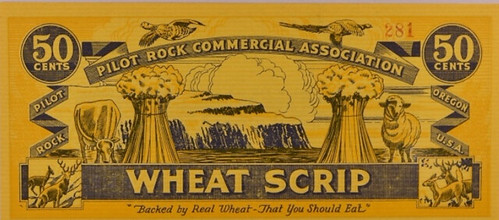
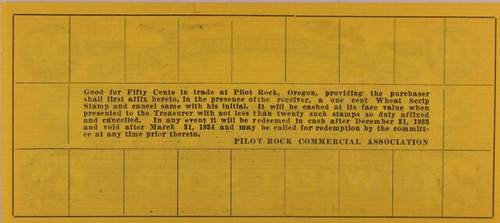
To read the complete article, see:
Wheat Script & A Railroad Note (Cited from: https://www.cointalk.com/threads/wheat-script-a-railroad-note.296544/)
(https://www.cointalk.com/threads/wheat-script-a-railroad-note.296544/)
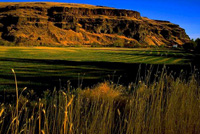 "The Rock", as it is known to locals, can be seen from the base of the Blue Mountains on a clear day 12 miles away.
"The Rock", as it is known to locals, can be seen from the base of the Blue Mountains on a clear day 12 miles away.
The City of Pilot Rock was named for the prominent basalt rock formation (pictured) located on the west side of the town which was visible from the old Oregon Trail and used as an aim point by wagon trains traveling Emigrant Pass and Cabbage Hill.
Pilot Rock is located in Northeastern Oregon approximately 15 miles south of Pendleton in the foothills of the Blue Mountains. It is a small community of 1542. The main industries are timber and agriculture. Pilot Rock is home to one mill: Boise Cascade /Kinzua Lumber, a lumber and pole mill.
To visit the Pilot Rock web site, see:
http://www.cityofpilotrock.org/

That pattern of rectangles on the back isn't just for decoration. Users of the scrip were supposed to affix a stamp in one of the blocks on making each transaction. The intention was to force the scrip to circulate among the community and facilitate commerce until the banks reopened.
I don't know the town's population in 1933, but must have been small. Could it support that level of scrip circulation? Searching for an image of one of these notes with stamps affixed, I came across a great 2010 article on the topic of stamp scrip from a the International Journal of Community Currency Research. I knew there were organizations out there for issuers of community currency, but was unaware of this journal. it was a delight to find. Here's an excerpt. -Editor
The Great Depression of the 1930’s led to considerable monetary experimentation. This paper, drawing mainly on examples from the American state of Iowa, examines the rise and fall of one of these experiments – stamp scrip. This was a self-liquidating currency: special stamps had to be affixed to the scrip certificate that financed a fund that would redeem the scrip once a sufficient number of stamps had been attached. Although the results of many stamp scrip experiments were disappointing, the best schemes provided some communities with benefits during the worst of the Depression. In the exceptional circumstances of a major financial meltdown, therefore, stamp scrip might conceivably be able to assist a community in reducing the effects on economic activity of such a shock.
A Short History of Stamp Scrip
America in 1932 was in crisis. Faced with declining tax revenues and increasing calls on their meagre resources to support the poor and destitute, local governments looked for alternative ways of
financing. Self-redeeming stamp coupons, stamp scrip, offered a possible way out. Two types of innovative self-liquidating community currencies emerged. Transactions stamp scrip addressed the cash
shortage problem. Each time the scrip was used a special stamp, purchased from the issuer of the scrip, had to be affixed to the scrip certificate. When the scrip had changed hands a sufficient
number of times, there would be enough money raised from the sale of stamps to redeem the scrip at par. For example, a one-dollar certificate requiring fifty transactions would pay for itself if each
stamp was sold at two cents.
Time-based stamp scrip, by contrast, required that a stamp be affixed to the scrip certificate every week (or fortnight, or month), regardless as to whether it had been used (or how many times it had been used) in the interim. There was also a hybrid version that combined the two: a stamp had to be affixed for each transaction, but if the scrip were not used by a the specified date, a stamp had to be stuck on to maintain its validity.
The idea of financing poor relief through the means of transactions stamp scrip appears to have originated in Anaheim, California, in 1931-32. A service station manager, Joe Elliott, devised a plan whereby the unemployed of the city would be given jobs on make-work schemes, and paid with special dollar certificates. They could spend this at the shops of participating merchants, who would then put a special four-cent stamp on the back of the certificate, before passing it on to their employees or customers. Each time the certificate was used, the receiving business was responsible for adding an extra four-cent stamp, until the certificate had 25 such stamps on the back, when there was enough money in the kitty to redeem the stamped coupon for cash.
The idea initially worked well. In January 1932 first twenty-five, and ultimately 157 men were working for the scrip. However, when the experiment came to an end after three months, there was too much scrip in issue, and too few stamps had been sold to redeem it. Elliott made up the shortfall, at a personal cost of $1800, around $30,000 in today’s money
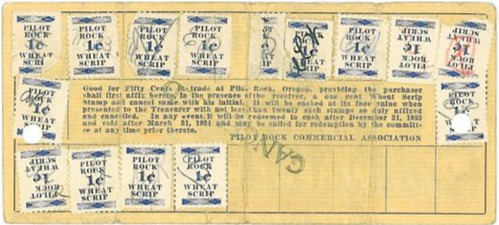
Sometimes an issue of scrip was partially backed by some commodity, which had a similar effect, increasing its acceptability. Pilot Rock, Oregon issued stamp scrip based on wheat: the 50c coupon required only 20 1c stamps to be affixed: the rest of the value was obtained from the wheat against which the scrip had been issued.
To read the complete article, see:
STAMP SCRIP IN THE GREAT DEPRESSION: LESSONS FOR COMMUNITY CURRENCY FOR TODAY?
(https://ijccr.files.wordpress.com/2012/05/ijccrvol142010a29-45warner.pdf)
BREAD TAG BONANZA
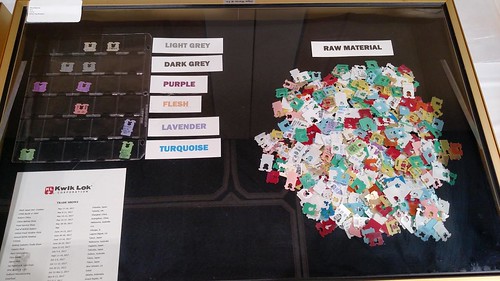
In my April 30, 2017 Numismatic Diary I described a number of exhibits I'd seen at the Central States Numismatic Society show. Describing an exhibit on classifying bread tags, I wrote, "The collecting instinct can lead many places. This exhibit was created by someone looking for something to collect that wouldn't break his budget. He decided to collect and categorize tags from bread loaves. It turned out to be an interesting study and a great multicase exhibit for the miscellaneous category."
Well, wouldn't you know it, but the Bread Tag Bonanza exhibit was created by one of our regular E-Sylum contributors. -Editor
Harry Waterson writes:
Thank you very much for the kind words about my exhibit. Tom Corey who was one of the three judges who graded the Misc. category wrote on his score sheet, “If this is not a joke, you do not need an intervention, you need psychiatric help.” I did notice that later when we were in the same dinner party, he sat as far away as possible.
This collection is for those of us who have a prominent 'collector' gene.
They can't help themselves.
They have to collect.
 After going through a family intervention and promising not to spend any more of the children's inheritance on coins and medals; this exhibit is this exhibitor's solution to a
collection he could put together that would cost nothing. Nada! Zilch! Zip! So far he has spent $20 on plastic pages to house the collection and $5 for a 3-ring binder to put it in. All reusable for
other purposes.
After going through a family intervention and promising not to spend any more of the children's inheritance on coins and medals; this exhibit is this exhibitor's solution to a
collection he could put together that would cost nothing. Nada! Zilch! Zip! So far he has spent $20 on plastic pages to house the collection and $5 for a 3-ring binder to put it in. All reusable for
other purposes.
And, of course, the bread tags are free. All one has to do is ask for them. Once family, friends and neighbors hear you are looking for bread tags, they pour in ─ even in Christmas cards, birthday cards and get-well cards. There has been one sympathy card.
The collecting of Bread Tags is rife with varieties. They come in different sizes and colors with odd-sized apertures and edges. A collector's dream. Something to organize, sort, arrange and rearrange to the collector's every whim. There are also naming rights.
It is rare that the exhibitor does not trip over a bread tag on entering or leaving a supermarket. To date, he has not yet succumbed to shoplifting bread tags.
The Bread Tag collection has a little more bulk than stamps, but is relatively weightless, when compared to a collection of quarters, nickels and dimes which can often require a wheeled handcart to move them about. Bread Tags also do not require storage in a safe or safety deposit box. There is no such thing as a Bread Tag rider on an insurance policy. In fact, when the exhibitor and his wife take a vacation, he often finds that the Bread Tag collection has been left strewn about the dining room table in hopes of catching the eye of a passing burglar.
The major manufacturer of all-plastic bag closures is the Kwik Lok Corporation of Yakima, WA. They exhibit at most major food packaging and container conventions. So far the exhibitor has managed to avoid attending any of these conventions but he is finding himself being seriously drawn to the International Baking Industry Exposition in Melbourne Australia June 20-22, 2017. This may require another family intervention.
Once the acquisition phase has achieved critical mass, the exhibitor is looking forward to developing the definitive Bread Tag Catalog, with a unique number for each known variety with the numbering system flexible enough to take into account future discoveries and varieties yet to be designed.
The exhibitor is, however, dragging his foot slightly in starting the Bread Tag Catalog. He knows that once he has solved the format of the catalog and begun the cataloguing process, the end is in sight. The Bread Tag binder will no longer be an object of constant attention. He will be forced to look about for another collection. A fate to be avoided, dare he say it, "at all costs."
This exhibit is laid out in Color Order, then by size, shape and aperture. There are 124 different tags in the exhibit. At the end of the exhibit is the collection of Raw Material amassed during the collecting process. The exhibitor so far has been unable to divest himself of this material. He desperately wants to be just a collector but his "accumulator" gene is still as active as his "collector" gene
To read the complete article, see:
WAYNE'S NUMISMATIC DIARY: APRIL 30, 2017 (http://www.coinbooks.org/v20/esylum_v20n18a20.html)
FRANKENSTEIN COUNTERFEITS SPLICED AND TAPED
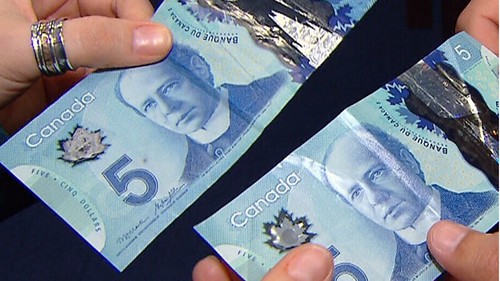
A counterfeit $5 bill, above, is shown with a real one. The holograms on the fake one have been replaced with foil, and tape has been substituted for the clear plastic panel.
Canadians are being warned to watch out for $5 bills cunningly held together by strips of tape and foil, in what police are calling a "splice and tape" trend among counterfeiters.
The sticky-tape switcheroo is affecting Canada's new $5 polymer bills, which have been touted as harder to counterfeit than the old paper banknotes. Police say counterfeiters are removing the clear panel near the side of the bill, which also contains two shiny, embedded holographic strips. The clear plastic is being replaced with tape, and tinfoil is being used as a substitute for the holograms.
Investigators suspect the real $5 panels are being repurposed to create higher-denomination counterfeits, while the cobbled-together $5 bills are being put back into circulation. The result is two Frankenstein-like sets of bills, with each containing elements of real and fake banknotes.
RCMP Cpl. Vinh Ngo, of the Federal Serious and Organized Crime unit, said the problem is widespread. "I think it's everywhere really," Ngo told CTV Vancouver. "There are no certain geographical patterns."
He added that there are "some elements" of organized crime involved in the counterfeiting.
When presented with the fake $5 bills, several Canadians in Vancouver couldn't immediately tell the difference.
"This is what these individuals prey upon – people not verifying the bank note," Bank of Canada analyst Farid Salji said.
Salji says Canadians should always check two or more of the security features on their bank notes, so they don't get duped by a Frankenstein bill. "Never rely on one," he said.
To read the complete article, see:
Check your wallet: RCMP warn of 'splice-and-tape' counterfeit bills
(http://www.ctvnews.ca/canada/check-your-wallet-rcmp-warn-of-splice-and-tape-counterfeit-bills-1.3415881)
HONG KONG STUDY EXAMINES BANKNOTE BACTERIA
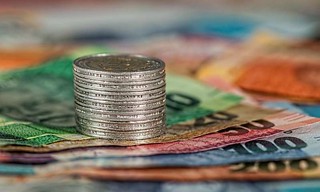 If a commonly used item passed from person to person everyday around the world was found to carry potential harmful microbes, would you continue to use it? Dr Jun Li from the University of
Hong Kong and his colleagues have been investigating the bacterial community present on banknotes, recently published in Frontiers in Microbiology.
If a commonly used item passed from person to person everyday around the world was found to carry potential harmful microbes, would you continue to use it? Dr Jun Li from the University of
Hong Kong and his colleagues have been investigating the bacterial community present on banknotes, recently published in Frontiers in Microbiology.
Due to the global public health concern of antibiotic resistance, Dr Li and his team realized the importance of investigating how microbes are passed between humans and how antibiotic resistance can be spread around the world. To do this, bacteria were scraped from the surface of banknotes collected from hospitals and metro stations around Hong Kong in areas of varying population density and grown in the lab to determine the bacterial presence.
Despite doubt as to whether microbes can even survive on banknotes, the researchers found that the banknotes offer an environment that can, indeed, accommodate living bacteria. Over one third of the bacteria identified on the banknotes consisted of potentially pathogenic species. Widely recognized pathogens like Escherichia coli and Vibrio cholera were among these species, of which some strains can lead to death in infected people.
Comparing the microbes found on banknotes with peoples' hands, metro station air, drinking water and marine sediment, Dr Li and his team found that the banknotes harbour a much higher diversity of bacteria than that of the environmental samples.
When comparing the number of antibiotic-resistance genes between banknotes and the other environmental samples, Dr Li and his team found that the banknotes have a significantly higher abundance than the other samples. Of particular interest were clinically important antibiotic-resistance genes (those that are significant in the medical world) which were also higher in the banknotes.
I am shocked - SHOCKED to learn there are microbes on my money.
Actually, I've lost count of how many studies I've seen about all the nasty things carried on banknotes. I get it - it's yucky. I understand the desirability of independently repeating experiments, but how many times do we have to measure this stuff to get the same result? Who is paying for all these duplicate studies around the world?
OK, I feel better now that I got that off my chest. I do understand these researchers are looking at different aspects of the problem. But after seeing study after study after study the sense of deja vu is overpowering. -Editor
To read the complete article, see:
Researchers have found that banknotes can transmit potentially pathogenic and antibiotic
resistant strains of bacteria (https://medicalxpress.com/news/2017-05-banknotes-transmit-potentially-pathogenic-antibiotic.html)
